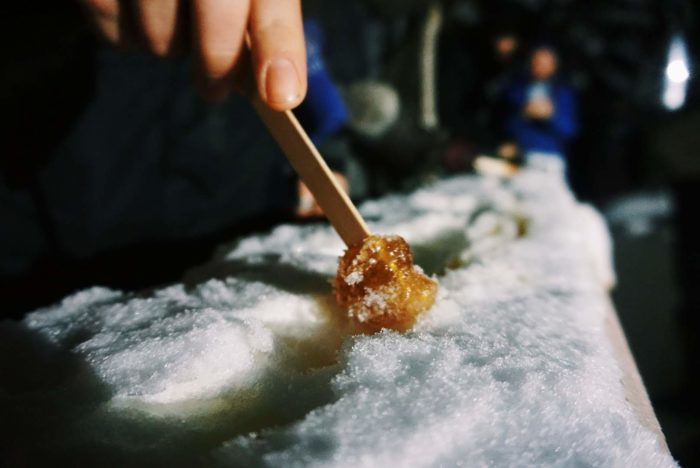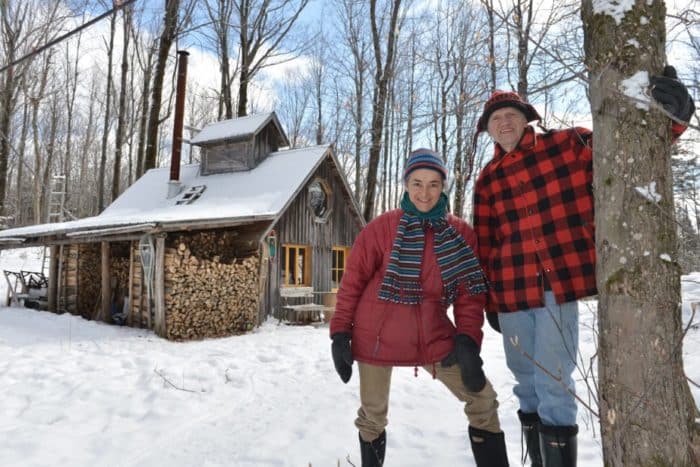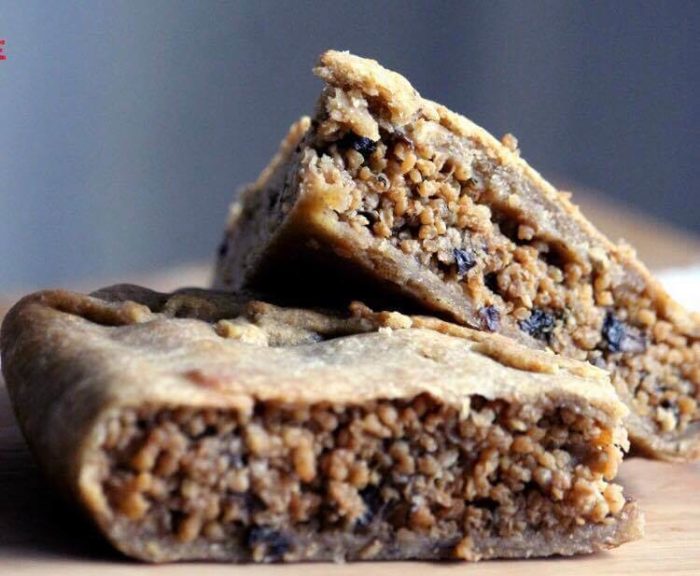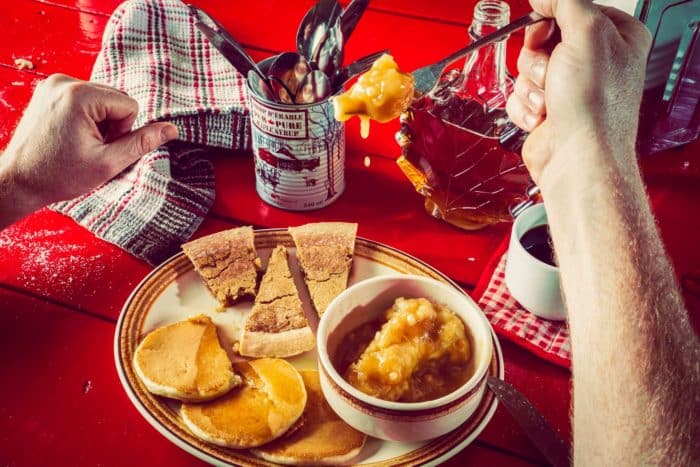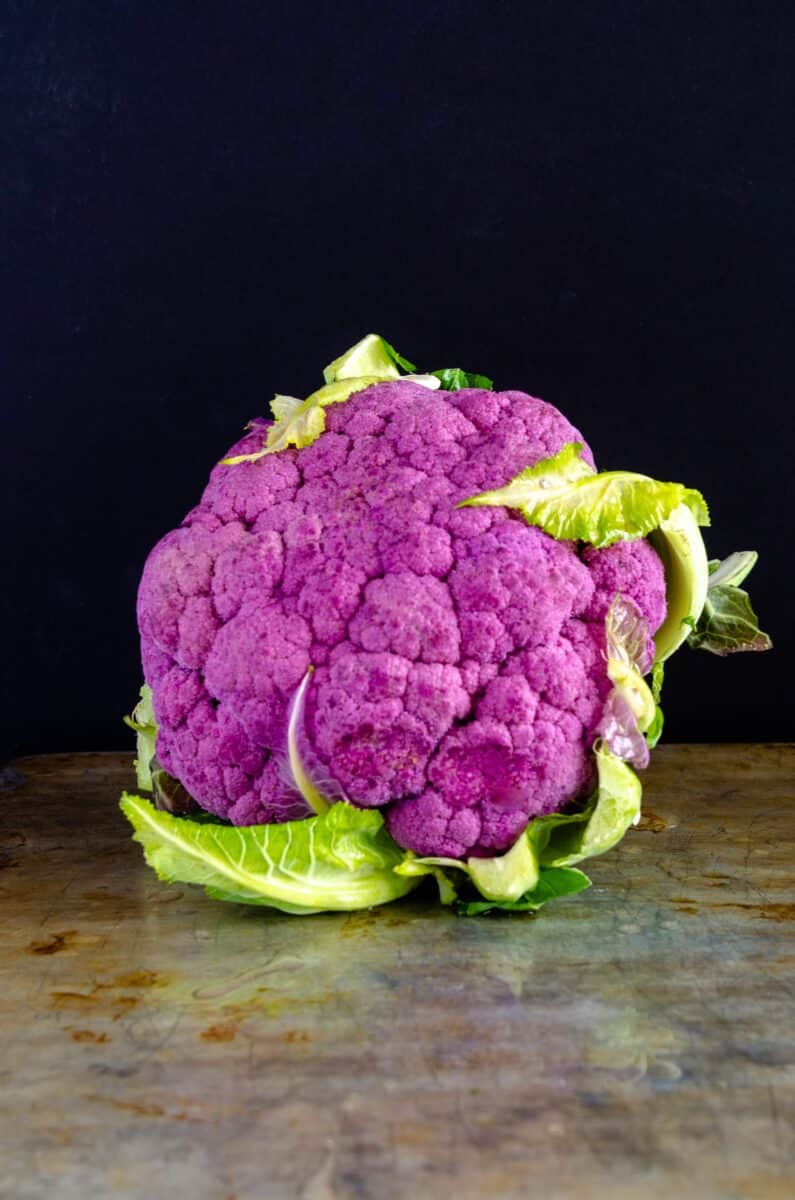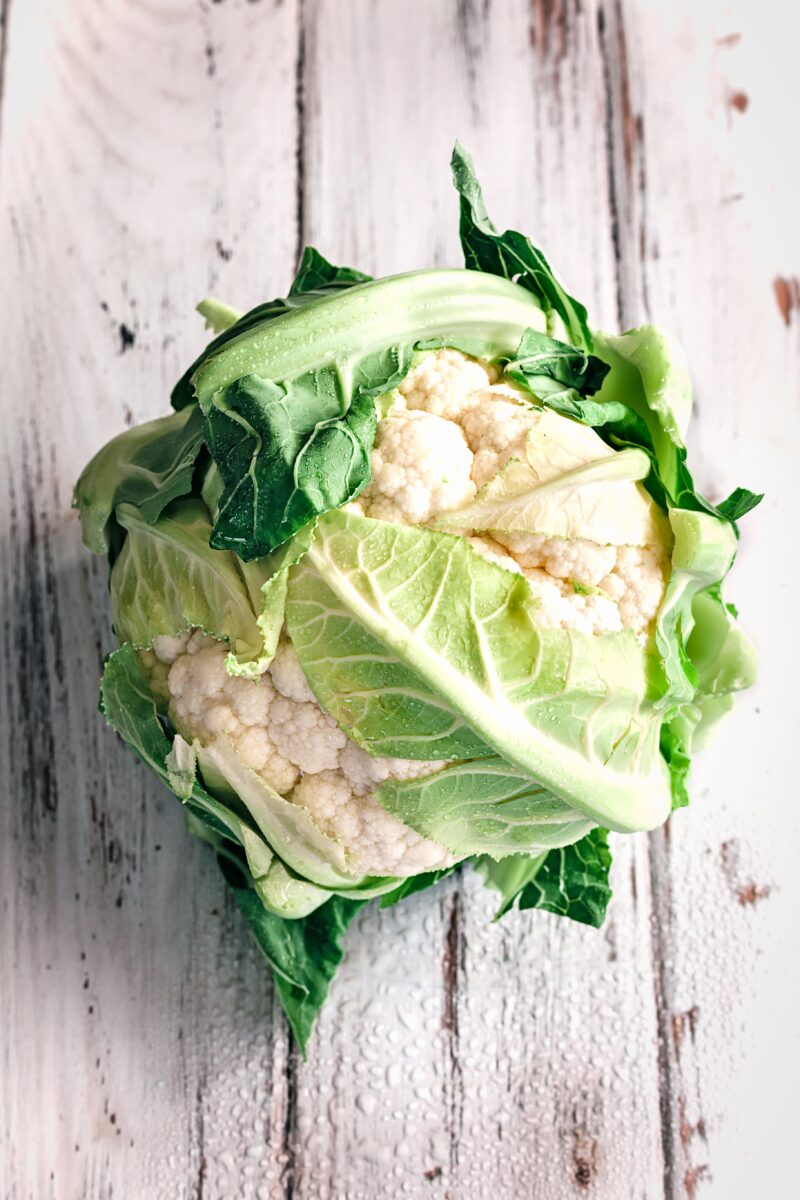Ce n’est pas parce qu’on est végane qu’on ne peut pas profiter du temps des sucres! De plus en plus d’érablières offrent des menus entièrement ou en partie véganes. D’autres encore ont concocté des cartes végétariennes à partir desquels les véganes peuvent se composer une généreuse assiette. Car ne l’oublions pas, la clé de voûte de tout repas de cabane à sucre – le fameux sirop d’érable – est 100 % végane! Voici donc notre sélection des meilleures cabanes à sucre véganes à ajouter à votre carnet d’adresses.
La Cabane à Tuque
La Cabane à Tuque, c’est le rêve de tout Québécois végane! Le menu, entièrement végétalien, affiche des versions repensées des recettes traditionnelles: soupe aux pois, cretons, fèves “pas de lard” et, bien sûr, tire sur la neige. Autre point positif: l’érablière est écologique puisqu’elle a été construite à partir de matériaux naturels ou recyclés. Du début du mois de février à la fin d’avril, on s’y rend en petit ou grand groupe (l’endroit peut d’ailleurs accueillir jusqu’à 35 personnes) afin d’y vivre une expérience rustique et végane à son meilleur!
La Pause Sylvestre
La Pause Sylvestre offre une expérience plus intime: avec 22 places, cette toute petite cabane nous laisse déguster un repas végétarien dans un décor douillet et féérique. L’érablière tenue par Mario Tremblay et Carole Bouthillette place les protéines végétales au coeur de ses créations culinaires. Pour y déguster un succulent repas végétalien, on fait appel à nos amis, parce qu’il faut louer la cabane en entier pour avoir droit à un menu totalement végane. On se le tient pour dit: la choucroute maison, les betteraves marinées, les crêpes de sarrasin et beaucoup de sirop d’érable donnent littéralement l’eau à la bouche. Mais attention: mieux vaut appeler d’avance pour y réserver sa place car même sans site web, La Pause Sylvestre connaît un retentissant succès.
Sucrerie du Domaine
Bien qu’elle soit réputée pour son menu « carnivore », la luxueuse cabane Sucrerie du Domaine offre des alternatives végétaliennes qui ne passent pas inaperçues. Tourtière, cretons et fèves au lard y sont répliqués de délicieuse façon, pour le plus grand plaisir des véganes. Refusant les compromis, les propriétaires ont mis trois ans à élaborer leur menu. Pour trouver grâce à leurs yeux, les plats devaient se rapprocher le plus possible des saveurs originales, avec des textures moelleuses et onctueuses. En guise de dessert, les becs sucrés peuvent choisir entre un pouding chômeur, une tarte au sirop d’érable pur et de la tire d’érable sur la neige. Miam!
Domaine Labranche
Le Domaine Labranche est une destination sucrée ayant tout pour plaire à celles et ceux qui ont des restrictions alimentaires. On y offre cinq menus : traditionnel, végétarien, végétalien, sans gluten et sans lactose. Ainsi, tout le monde peut profiter pleinement du repas! Au menu végane, on retrouve entre autres des cretons végétariens et un tofu brouillé au sirop d’érable. On déguste notre repas dans une atmosphère conviviale et chaleureuse avant de sortir se sucrer le bec de tire sur la neige. Un pur délice!
Val des Rosacées
L’érablière Val des Rosacées, située au cœur de la région vallonnée de St-Joseph-du-Lac, tout près de Mirabel, accueille avec panache les adeptes de cabane à sucre en tous genres. En marge du menu traditionnel, on y propose des options végétariennes, en grande partie véganes. Mis à part le brie fondant et l’omelette, le reste du menu salé est végane. Et difficile de ne pas craquer d’emblée pour les célèbres “bines à Line”, le jambon végane et, bien sûr, les saucisses GUSTA! Chaque semaine, une énorme salade de fruits est préparée pour la clientèle végane… Et on prend soin d’y saupoudrer du sucre d’érable. Il y en a donc pour tous les goûts et – parole d’honneur – on en redemande!
Force est de constater qu’il existe de plus en plus d’alternatives pour les véganes au bec sucré. Les érablières s’adaptent à la demande changeante de leur clientèle et on les applaudit! Car cette délicieuse tradition québécoise a tout pour plaire au plus grand nombre.
Et de retour en ville, on prolonge le plaisir à la maison avec notre recette de tourtière végane et son ketchup maison… Vive le temps des sucres!
Quand on adopte une alimentation végane, on doit ajuster dans la foulée nos habitudes culinaires, nos façons de faire… et (dans une certaine mesure) le contenu de notre garde-manger et de notre frigidaire! Quels sont les musts du véganisme, ces ingrédients de base qui permettent de cuisiner des recettes véganes goûteuses, variées et bluffantes? En voici la liste sommaire. Prêt(e)s? À nos stylos et tablettes!
Pour nous sucrer le bec
Exit le miel, qui est directement le fruit du travail des abeilles, et le sucre blanc, dont les processus de blanchiment nécessitent parfois l’usage d’os d’animaux. Pour ravir notre dent sucrée et rehausser avec brio nos desserts sans mettre à mal le monde animal et environnemental, il existe tout un tas d’alternatives véganes succulentes. À inscrire sur notre liste d’épicerie:
- Sirop d’érable
- Purée de dattes
- Sirop d’agave
- Mélasse
- Sucre de canne
Pour un effet lacté
Envie d’onctueux lattés ou de plats en sauce? On peut enrichir nos recettes de crème tout en laissant les vaches brouter tranquillement les champs, ou les chèvres bêler à leur guise dans les pâturages. Oui, oui! Car au lieu des produits laitiers animaliers, il suffit de se tourner vers les laits végétaux qui – en prime – sont exempts de lactose (donc, faciles à digérer). Des suggestions:
- Lait d’amande
- Lait d’avoine
- Lait de coco
- Lait de riz
- Lait de chanvre
En lieu et place du beurre
Le matin, sur des tartines grillées, les beurres de noix préparés sans produits laitiers sont à la fois nourrissants et décadents (beurre d’arachides, beurre d’amandes, beurre de pistaches, etc.). Même constat pour la margarine végane, à base entre autres d’huile d’olive: elle est délicieuse en plus de nous fournir un bon apport d’omégas-3. À consommer à froid (sur du pain) ou à utiliser pour la cuisson.
En substitution des œufs
Le tofu ferme, haché, assaisonné et cuit dans un poêlon, ressemble à s’y méprendre aux œufs brouillés qu’on sert au petit-déjeuner ou en sandwich. Si on désire plutôt préparer des mousses et des meringues aériennes, il suffit de remplacer les traditionnels blancs d’œufs par l’eau contenue dans les conserves de pois chiches ou l’eau de leur cuisson (appelée aquafaba). La farine de pois chiches permet, quant à elle, de préparer de chouettes omelettes sans jaunes d’œufs. L’agar-agar est imparable pour obtenir des textures gélifiées. Sans oublier les flocons d’avoine et la poudre d’amidon, capables d’épaissir les sauces.
Ces denrées de base permettent d’adapter tout un tas de recettes classiques en recettes véganes. Il est donc recommandé de les ajouter à notre liste d’épicerie, pour en faire les piliers de notre garde-manger végé. Et voici un autre bon filon: s’arrêter au rayon frais de notre épicerie préférée afin de glisser dans notre panier des saucisses, rôtis, fauxmages, cretons et pâtés véganes GUSTA. Ça facilite la vie et la préparation des repas. Et c’est bon à s’en lécher les doigts! #VivementLeVéganisme
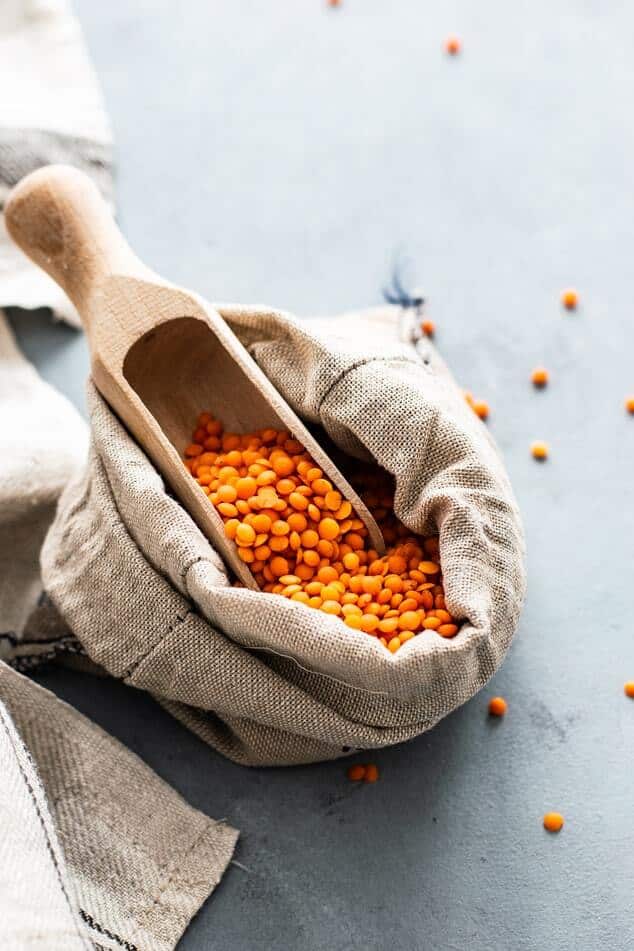

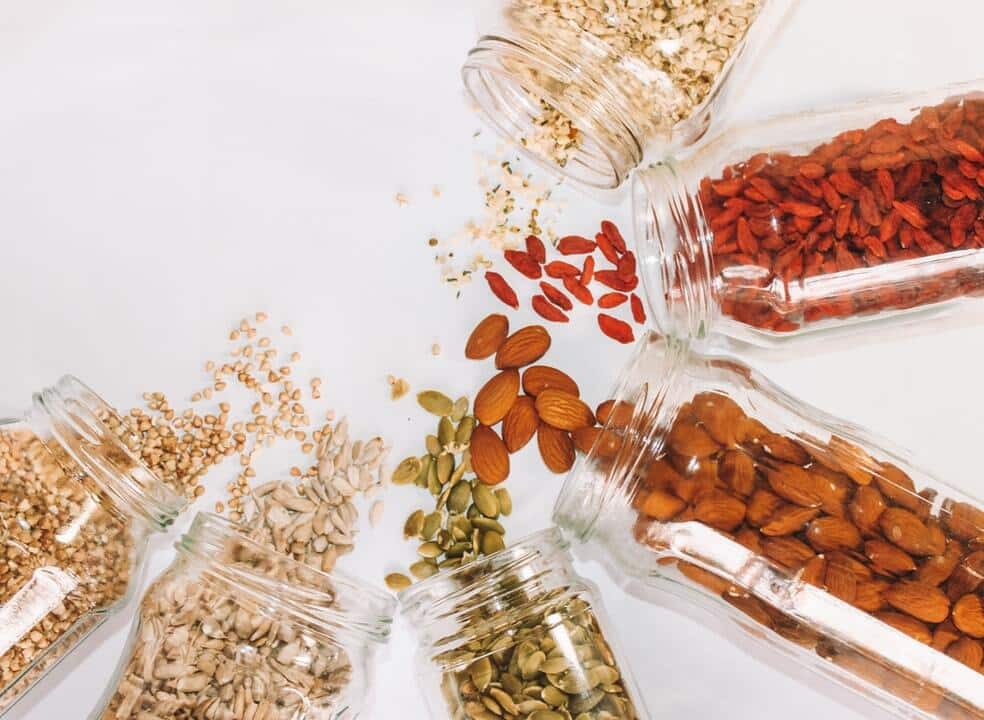
Crédit photo entête: Vegan Liftz
Entre le végétarisme, le véganisme et le végétalisme, on retrouve également le flexitarisme. Avec toutes les pratiques alimentaires qui existent aujourd’hui, il peut être facile de s’y perdre. C’est pourquoi on vous aide à démêler le régime alimentaire flexitarien, le tout dernier mode de consommation popularisé. Celui-ci compte de plus en plus d’adeptes partout à travers le monde.
Le flexitarisme, c’est quoi ?
D’abord, répondons à la fameuse question que plusieurs se posent. Comme son nom l’indique, les flexitariens sont souples dans leur alimentation. Ils tentent de réduire et de limiter leur consommation de viande et de poisson. Contrairement aux végétaliens ou aux végétariens qui arrêtent complètement de manger de la viande et qui éliminent plusieurs aliments de leur quotidien, le flexitarisme n’en proscrit aucun. Toutefois, dans ce type de régime alimentaire, une consommation riche en fruits et légumes est encouragée et bien sûr, les produits transformés sont écartés.
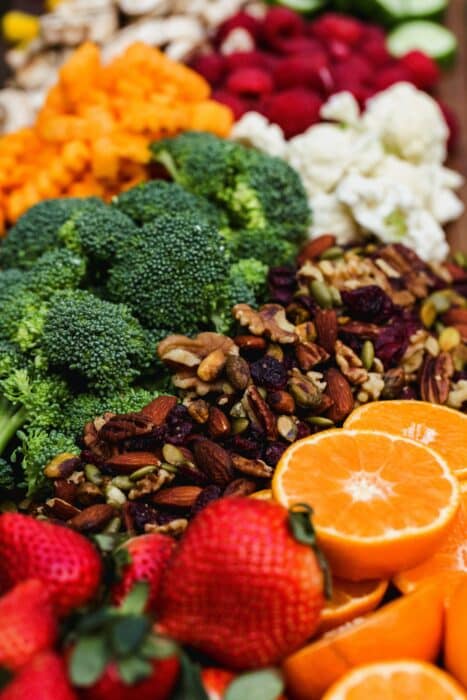
Pourquoi pratique-t-on le flexitarisme ?
Certaines personnes ne sont pas nécessairement prêtes à prendre le virage végétarien, végétalien ou vegan parce qu’il peut sembler très strict, mais elles désirent tout de même faire de petits gestes significatifs pour l’environnement, les animaux et leur santé.
Le flexitarisme se concentre davantage sur les aliments de qualité. Lorsque de la viande est consommée, elle est achetée chez le boucher du coin et elle est issue d’élevage sain ou bio. Les flexitariens sont consciencieux. Ils savent qu’en plus des questions éthiques, les gros élevages de bétail causent des problèmes environnementaux tels que les émissions de gaz à effet de serre, la déforestation, un grand apport en eau, etc.
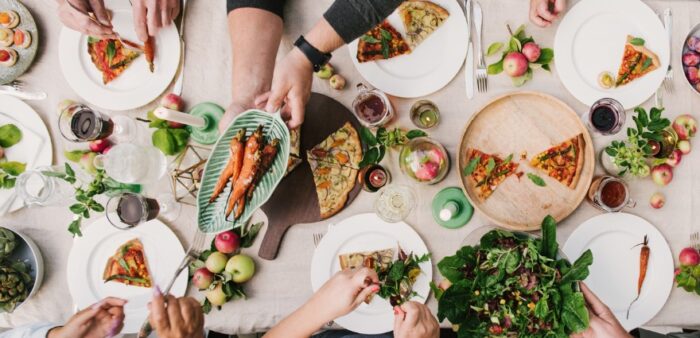
Débuter le flexitarisme
Toutes ces informations sont très utiles, mais si tu veux vraiment te mettre au flexitarisme, comment faire ?
- Réduire ta consommation de viande et de poisson (idéalement à une à deux fois par semaine)
- Acheter des produits avec le moins d’emballage possible
- Se concentrer sur des produits de qualité (biologiques, peu transformés, etc.)
- Augmenter ta consommation de fruits, de légumes et de céréales
- Consommer des produits locaux
Tu peux débuter ta transition doucement et ajuster ta consommation au fil des semaines. Tu verras ; le changement se fait plutôt doucement. N’oublie pas que l’équilibre est le mot d’ordre du flexitarisme.

3 mythes à déconstruire sur le flexitarisme
Être flexitarien, ça coûte cher
Au contraire, ce mode de consommation, dans certains cas, réduit considérablement la facture de l’épicerie. Acheter des produits biologiques et de la viande issue d’élevage sain n’est pas tellement plus dispendieux. En plus, si tu achetais autrefois de la viande pour tous tes repas de la semaine, une partie de ce montant épargné te servira maintenant à acheter tes produits locaux chez de petits marchands. Il faut bien entendu planifier son budget, comme c’est le cas avec n’importe quel type d’alimentation.
Être flexitarien, c’est pour se déculpabiliser de ne pas être vegan
Être vegan, c’est tout un mode de vie et il est possible de le faire progressivement. Il y a des étapes à suivre et le flexitarisme s’imbrique bien dans celles-ci. Pour certaines personnes, c’est donc un pas de plus vers le véganisme ou le végétarisme.
Pour d’autres, il n’est pas question de mettre la consommation de viande complètement de côté ! Toutefois, ces personnes veulent faire leur part pour l’environnement, les animaux et leur santé. Ce virage fait partie des petits gestes simples qui auront un grand impact sur notre planète à long terme.
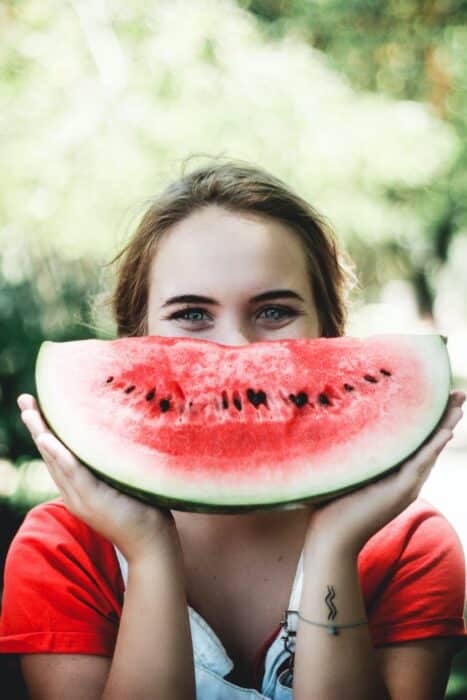
Être flexitarien n’apporte pas assez de nutriments au corps
Quel mythe ! D’ailleurs, beaucoup d’athlètes d’excellence ont eu la chance de le démentir dans les dernières années. Plusieurs d’entre eux se tournent désormais vers le flexitarisme dans le but d’avoir une alimentation équilibrée et de consommer des produits sains pour leur corps (leur outil de travail). En effet, les nutriments présents dans la viande peuvent être trouvés dans d’autres aliments. La clé est de manger diversifié, d’essayer de nouvelles recettes et de découvrir des ingrédients.
Bref, le flexitarisme, c’est un régime alimentaire assez accessible pour tous ceux qui ne désirent pas faire des changements drastiques, mais qui veulent tout de même faire leur part écologique et pour les animaux et leur santé.
Nouvelle année veut dire nouvelles résolutions ! Et si celles-ci incluent un changement au niveau de ton assiette, tu dois certainement planifier tes nouvelles habitudes pour que celles-ci perdurent. Que tu le fasses pour des raisons de santé, écologiques ou éthiques, il est important d’avoir une assiette équilibrée et de cuisiner avec plaisir.
Voici nos 4 conseils pour réduire ta consommation de produits d’origine animale :
1- Fixer une journée par semaine pour les repas végé
Inutile de remplir ton frigo de tofu et de tempeh, si tu n’aimes pas ça ou que tu n’en as jamais consommé. Mieux vaut apporter des changements graduels à ton alimentation, plutôt que de frustrer ton corps avec des changements drastiques.
Pour ceci, tu peux commencer par manger végé seulement une fois par semaine.
À titre d’exemple, le mouvement « lundi sans viande » a eu beaucoup de succès à travers le monde et a aidé plusieurs personnes à faire graduellement leur transition vers une alimentation végéta*ienne.
2- Favoriser les protéines végétales
Certaines personnes pensent qu’il faut compenser les protéines animales avec des protéines végétales en poudre (généralement dispendieuses). Et pourtant, ces composés sont plus accessibles que ce que l’on croit. On les trouve dans les légumineuses, le tofu, le tempeh, le seitan et la protéine végétale texturée (PVT).
Si tu as du mal à comprendre la signification de ces ingrédients, sache que nous sommes tous passés par là ! Pour te familiariser avec le jargon de l’alimentation végétalienne, nous t’invitons à lire notre article sur les sources de protéines végétales.

3- Essayer les produits de substituts
Du fauxmage, des saucisses végétaliennes, des boulettes avec des légumes ou encore de la fausse viande hachée, tu ne manqueras de rien pour réinventer de meilleures recettes version végé : lasagnes à la PVT texturée, pizza 4 fauxmages, hot dog aux saucisses de blé, pâté chinois au haché végé et bien plus !
De plus, les substituts sont généralement faciles à préparer et bien assaisonnés. De quoi gagner du temps lors des journées chargées tout en éprouvant du plaisir.
Envie de magasiner pour des produits qui te feront aimer la cuisine à base de plantes ? Jetteun coup d’œil à nos articles !
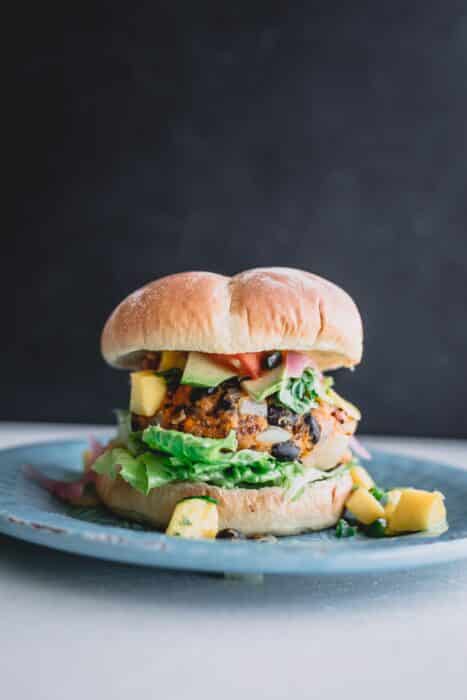
4- Tester de nouvelles recettes
Rien de mieux que de briser la routine avec des recettes que tu n’as jamais essayées avant. Tes invités et tes papilles seront sans doute agréablement surpris par les changements que tu apportes à ta table !
Pour trouver de l’inspiration et ne pas trop prendre de risques avec de nouvelles textures et combinaisons de saveurs, tu peux te procurer des livres de cuisine ou simplement t’abonner à des blogues et chaînes YouTube de foodies véganes.
Pour ceci, nous te recommandons les ressources suivantes :
- La chaîne YouTube de La Petite Okara
- Les fameux livres de La Cuisine de Jean Philippe
- Les recettes de Végane, mais pas plate!
- Les recettes de Loounie
- Les livres de Ma Cuisine de Tous Les Jours
- Les recettes de Edgy Veg
- La chaîne YouTube de Liv B
- Les recettes de Hot For Food
- Les recettes de Cheap Lazy Vegan
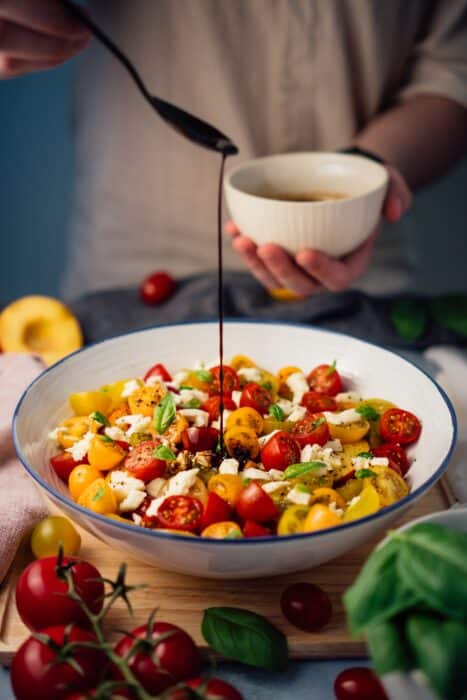
Nous espérons que ces astuces te motiveront à sauter le pas et à apporter de petits changements dans ton assiette. Entre-temps, nous te recommandons de découvrir notre section Gustarium là où tu trouveras une foule de conseils qui t’aideront à réussir ta transition. Enfin, si on t’a convaincu et que nos produits GUSTA finissent dans ton panier d’épicerie, tu peux toujours tester nos succulentes recettes !
Plus que quelques semaines avant Noël et chez GUSTA nous avons déjà sorti nos chandails tricotés pour nous mettre dans l’ambiance. Bien que cette période soit l’occasion idéale pour se réunir en famille et exprimer notre attachement à nos proches, il n’en reste pas moins que c’est aussi la fête de la surconsommation et du gaspillage alimentaire, si l’organisation n’est pas bien réfléchie.
Heureusement, il existe toujours des solutions faciles et économiques pour rendre ton Noël éco responsable et éthique.
Voici 4 façons de passer un Noël responsable :
1. Opter pour des cadeaux vintages
Le vintage c’est la nouvelle mode et cela réjouit la planète ainsi que nos portefeuilles. Une foule de friperies en ligne et de magasins spécialement conçus pour vendre des articles rétro sont disponibles.
Même si certaines pièces de collection peuvent être chères, ces endroits sont LA destination parfaite pour trouver des objets de valeur véhiculant un message symbolique.
Offrir un cadeau vintage à tes proches les ramènera dans une ancienne belle époque !

Voici quelques adresses qui feront ton bonheur :
MONTRÉAL
- Esprit Vintage: 1380 Rue du Pont, Marieville, QC J3M 1G2, Canada
- Kitschy Koo: 1465 rue Bélanger Montréal
- Kitsch à l’os ou pas : 3439 rue Hochelaga Montréal
- Citizen Vintage Mile-End : 5330 Boul. Saint-Laurent, Montréal, QC H2T 1S1, Canada
- EVA B : 2015 Boul. Saint-Laurent, Montréal, QC H2X 2T3, Canada
- Ruse boutique : 5141 Boul. Saint-Laurent, Montréal, QC H2T 1R9, Canada
TORONTO
- Chosen : 1599 Dundas St W, Toronto, ON M6K 1T9, Canada
- 96 Tears Vintage: 1267 Bloor St W, Toronto, ON M6H 1N7, Canada
- The Handwork Department: 1884 Danforth Ave, Toronto, ON M4C 1J4, Canada
VANCOUVER
- F as in Frank Vintage Clothing: 2425 Main St, Vancouver, BC V5T 3E1, Canada
- Woo Vintage Clothing: 4393 Main St, Vancouver, BC V5V 3R1, Canada
- Community Thrift & Vintage FROCK SHOPPE: 311 Carrall St, Vancouver, BC V6B 2J4, Canada
2- Bien choisir son sapin
Plusieurs options s’offrent à toi pour diminuer ton empreinte écologique tout en ayant un petit arbre décoratif de Noël !
Tout d’abord, aux oubliettes les sapins artificiels. Bien qu’ils soient réutilisables, ces derniers sont polluants puisqu’ils sont fabriqués avec du plastique. Ellipsos a réalisé une étude sur le cycle de vie du sapin naturel en le comparant à celui du sapin artificiel. Grande surprise ! Un sapin de Noël artificiel émet à peu près 8,1 kg de CO2 pour sa production et pour son transport, alors qu’un sapin naturel n’émet que 3,1 kg de CO2, soit moins de la moitié de la première option ! De plus, pour rentabiliser l’empreinte carbone d’un sapin artificiel, il faudra l’utiliser pendant 20 ans. On s’entend qu’au bout de 3 ans, ces derniers finissent à la poubelle soit par usure ou simplement pour changer!
Pour un sapin respectueux envers l’environnement, tu peux opter pour un achat local et biologique. Tu peux également le replanter dans ton jardin après les fêtes pour éviter de le jeter.
Les moins capricieux peuvent se contenter d’un sapin dans un pot qui ornera leur maison tout au long de l’année.
Si aucune de ses options ne te semble intéressante, sache qu’il y a également des entreprises qui louent des sapins. Cette option à la fois rentable et écologique permet de limiter le gaspillage des sapins.
Les créatifs quant à eux peuvent se tourner vers la fabrication de leur propre sapin à l’aide d’objets à recycler, de livres, de guirlandes ou de journaux. Il s’agit d’une belle activité à faire en famille afin de divertir les enfants et les inclure dans les préparatifs des fêtes.

3. Emballer ou pas !
Les emballages cadeaux finissent souvent à la poubelle, alors pourquoi le fait-on ? Tout ce qui compte, c’est ce qu’il y a à l’intérieur, non?
Si tu tiens à ce que ton cadeau soit instagrammable pour bien décorer ton sapin de Noël, tu peux toujours opter pour un emballage écolo.
Les emballages en tissu, c’est la tendance de l’année ! En plus, d’être réutilisables, ces emballages sont plus chics !
Voici une vidéo qui t’inspirera lors de ton prochain emballage cadeau:
Le furoshiki : emballage cadeau zéro déchet

4. Moins de viande, plus de légumes !
Tu aimes cuisiner pour tes invités durant cette période de rassemblement ? Le repas, c’est le meilleur moment de Noël : toute la famille se réunit pour partager des mets traditionnels et authentiques. Et pourquoi pas leur faire découvrir quelques-unes de tes recettes végétaliennes?
Pour ceci, tu peux jeter un coup d’œil au livre du chef favoris des végé, La Cuisine de Jean-Philippe : Mes grands classiques véganes.
Tu y trouveras des plats de famille véganisées !
Tu peux aussi toujours opter pour nos alternatives véganes qui te faciliteront les préparatifs : un plateau de fauxmages pour l’apéro, des saucisses végé à l’entrée, du pâté végane à mettre sur tes toasts, etc.

Nous espérons que ces astuces t’aideront à débuter tes résolutions bien avant le mois de janvier. Dès Noël, tu pourras commencer à appliquer tes nouvelles habitudes pour assurer un meilleur avenir pour la planète, un petit geste à la fois.
L’automne, quel beau moment pour aller cueillir des pommes et des citrouilles ! Ce qu’on aime aussi particulièrement, ce sont les journées de cuisine qui s’ensuivent. Chaque année, c’est toujours pareil : on a beaucoup trop de ces fruits et on ne sait plus quoi en faire ! C’est donc le moment idéal pour essayer plusieurs délicieuses recettes végétales à base de pommes et de citrouilles.
Voici donc 7 recettes à base de plantes qui plairont assurément à tes papilles gustatives.
Croustade aux pommes végane
Pas trop original nous diras-tu ? On s’entend pour dire qu’il n’y a rien de comparable à une bonne croustade aux pommes en revenant de ta cueillette. Fondante dans la bouche, c’est probablement l’une des recettes les plus faciles à cuisiner et ça te rappellera tes doux moments d’enfance.
Les ingrédients
Croustillant
- 1 ½ tasse de flocons d’avoine
- 1 ½ tasse de farine tout usage
- ⅔ tasse de cassonade pressée
- ½ cuillère à thé de sel
- ½ tasse de beurre végan ou de margarine
Garniture
- 10 pommes Cortland ou McIntosh, pelées et coupées
- ½ tasse de cassonade pressée
- ½ cuillère à thé de cannelle moulue
Pour voir les instructions, c’est ici.
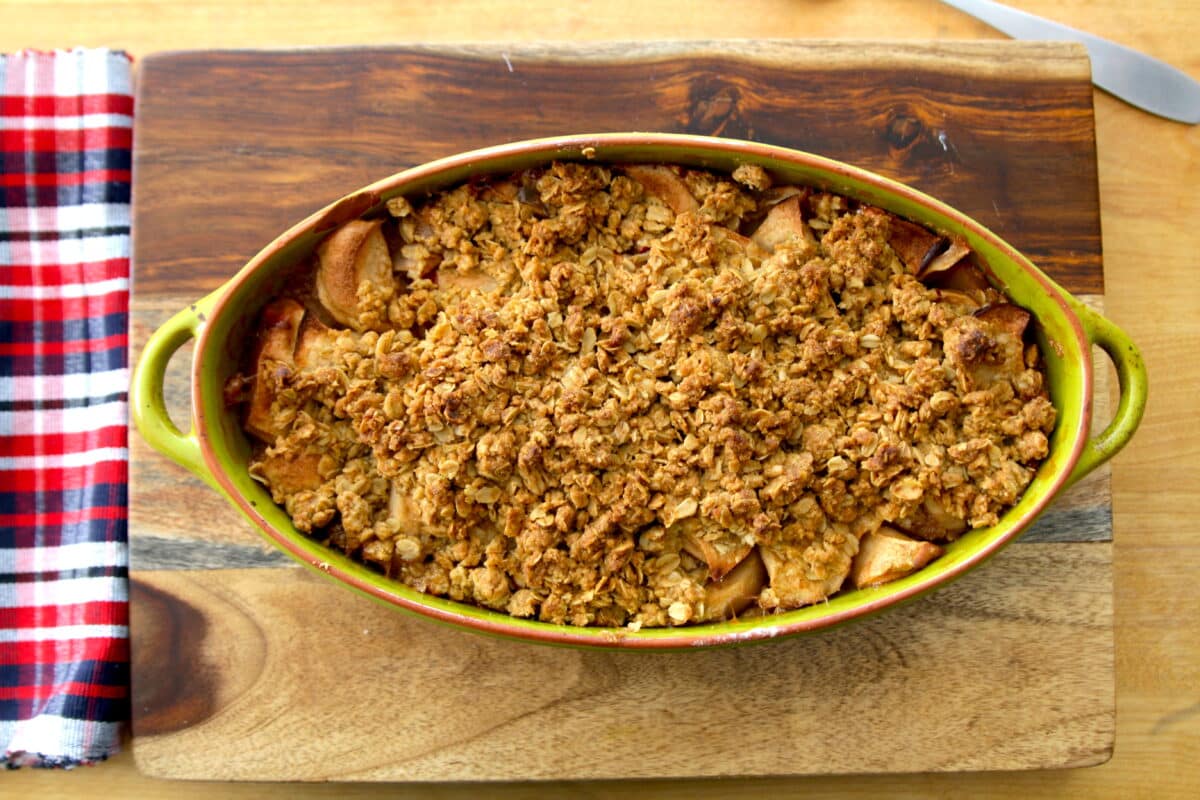
Beurre à la citrouille épicé
Pour faire changement du beurre d’amande, voici une délicieuse alternative à mettre sur tes rôties ou tes pâtisseries le matin. Sucrée à point et trompeuse par son nom, cette recette ne contient même pas de beurre ! On te laisse l’essayer et en juger.
Les ingrédients
- 2 tasses de purée de citrouille (faite maison ou du marché)
- ½ cuillère à soupe d’épices à tarte à la citrouille
- ½ tasse de dattes
- ½ tasse d’eau
- 3 cuillères à soupe de sirop d’érable
- ½ cuillère à thé d’extrait de vanille
- 1 cuillère à soupe de vinaigre de cidre de pomme
- 1 pincée de sel
Pour les instructions, c’est ici.

Gâteau moelleux aux pommes
Ce gâteau est littéralement à tomber par terre ! Sa texture moelleuse et son goût juste assez sucré sont ce que l’on aime par-dessus tout. Cette recette est à cuisiner avec tes personnes préférées lors d’un dimanche pluvieux cet automne.
Les ingrédients
Croustillant
- 1 cuillère à thé de farine de sarrasin
- 3 cuillères à soupe de sirop d’érable
- ½ tasse de noix de Grenoble
Gâteau
- 2 grosses pommes, pelées et coupées
- ¼ tasse de farine de riz
- ¼ tasse de sucre
- 2 oeufs
- 75 ml de lait végétal au choix
- 1 cuillère à soupe de purée d’amandes
- ½ cuillère à thé de cannelle moulue
Pour les instructions, c’est ici.
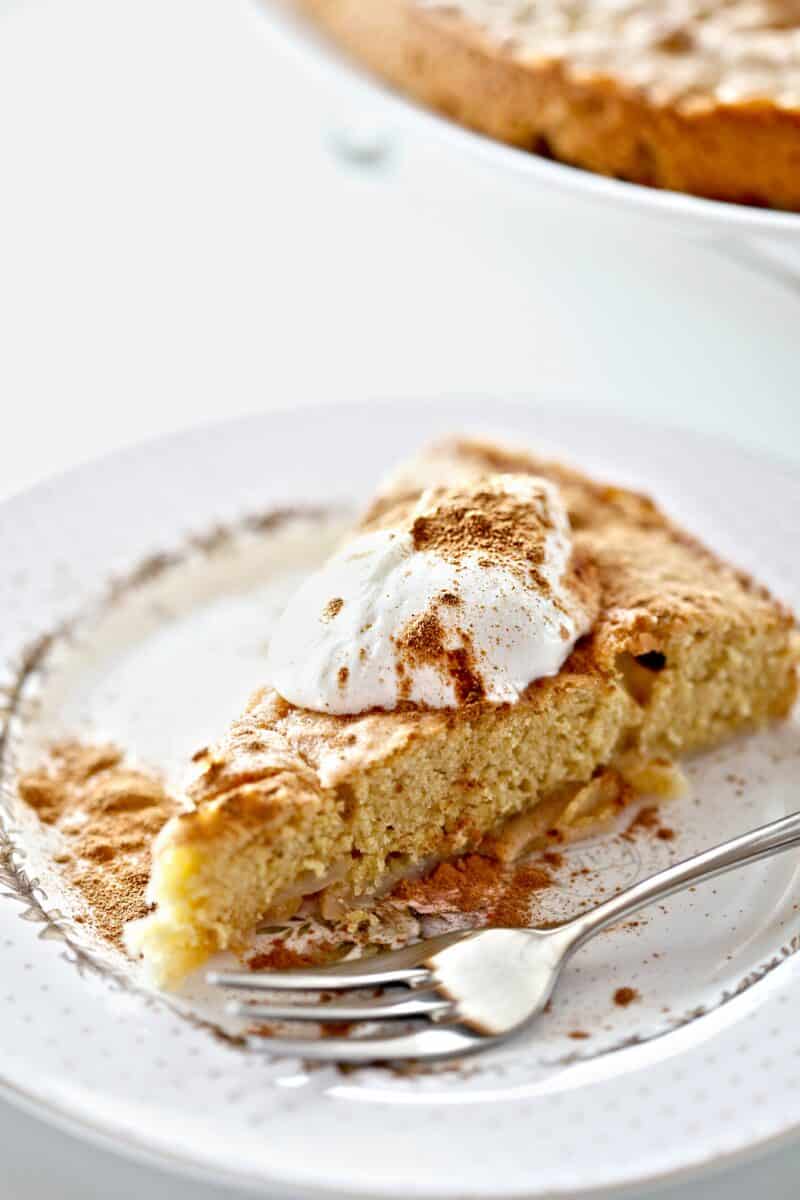
Biscuit citrouille et chocolat
Qu’est-ce qui goûte plus l’automne que la citrouille et les épices ? Ces délicieux biscuits au chocolat et à la citrouille sont non seulement réconfortants, mais ils sont aussi bons pour la santé. Faibles en gras et faits avec des ingrédients naturels, ils font une excellente collation.
Les ingrédients
- 1 cuillère à soupe de graines de lin moulues
- 3 cuillères à soupe d’eau tiède
- ¼ tasse de compote de pommes non-sucrée (tu peux aussi la concocter toi-même)
- ¼ tasse d’huile de canola
- 1 tasse de purée de citrouilles (faite maison ou du marché)
- ½ tasse de sucre
- 1 cuillère à thé d’extrait de vanille pure
- 1 cuillère à thé de bicarbonate de soudre
- 1 cuillère à thé de lait végétal au choix
- 2 cuillères à thé de cannelle bio
- 1 cuillère à thé piment de la Jamaïque ou quatre-épices
- 2 cuillères à thé de poudre à pâte
- ½ cuillère à thé de sel
- 1 tasse de farine de blé entier
- 1 tasse de farine tout usage
- 1 tasse de brisures de chocolat végétalien
Pour les instructions, c’est ici.
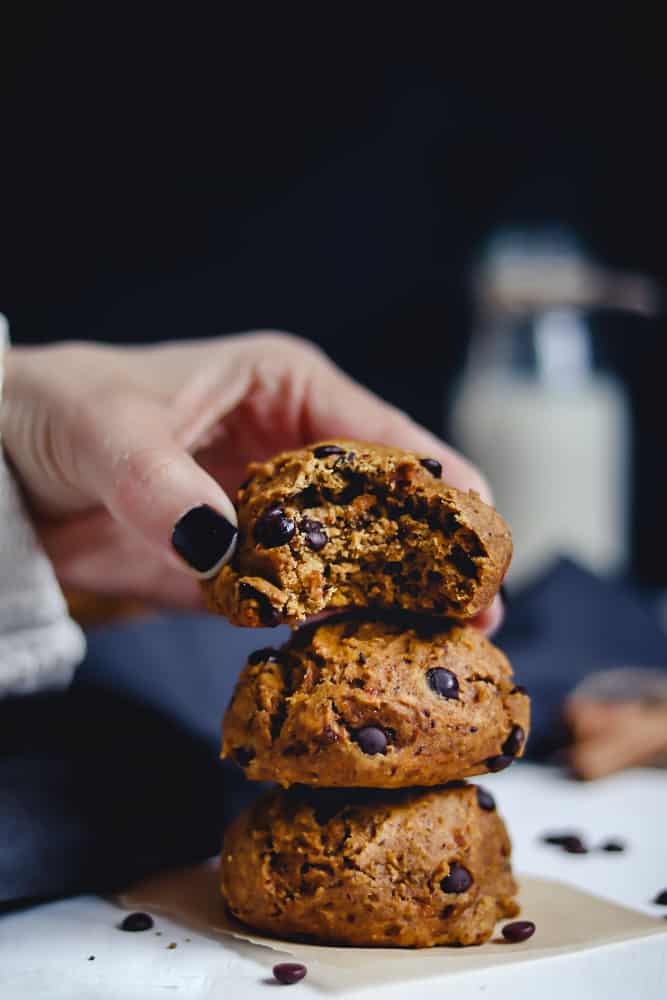
Beignes aux pommes
On ne pouvait certainement pas écrire un article de recettes sans incorporer de délicieux beignets faits maison. Pour un dessert vite fait, bien fait qui requiert très peu d’ingrédients, celui-ci sera ton meilleur ami.
Les ingrédients
- 1 tasse de farine de blé
- 1 tasse de sucre en poudre
- 100 ml de lait végétal au choix
- 4 moyennes pommes, pelées et coupées
- 1 cuillère à thé de cannelle moulue
- Huile pour la friture
Pour les instructions, c’est ici.

Tartelette aux pommes
La fameuse tarte aux pommes, un classique post-cueillette ! Dans cette recette, une petite variante est proposée : les mini tartelettes pour éviter le gaspillage (ou éviter de manger la tarte complète en une journée). En plus d’être très mignonnes, ces petites merveilles de 4 pouces de large sont délectables.
Les ingrédients
- 250g de pâte à tarte
- ½ tasse de compote de pommes non-sucrée (tu peux aussi la concocter toi-même)
- ¼ de cuillère à thé de cannelle moulue
- 2 petites pommes tranchées
- 1 cuillère à soupe de cassonade
Pour les instructions, c’est ici.

Carrés à la citrouille
La collation par excellence pour les petits et les grands ! On trouve du confort dans la variété d’épices que ces carrés à la citrouille contiennent. Ils sont si bons et tendres ; on voudrait en manger matin, midi et soir. Le défi : essayer de ne pas tout avaler en une seule journée.
Les ingrédients
- 60 ml de lait végétal
- 60 ml de sirop d’érable
- 80 ml de beurre végétal fondu
- 1 tasse de purée de citrouille (faite maison ou du marché)
- 2 cuillères à soupe de graines de lin mélangées à 4 cuillères à soupe d’eau
- 1 tasse de farine de blé entier
- ½ cuillère à thé de poudre à pâte
- ¼ de cuillère à thé de bicarbonate de soudre
- ½ cuillère à thé de gingembre moulu
- ¼ de cuillère à thé de muscade
- ¼ de cuillère à thé de cardamome
- 1 pincée de sel
- ¼ de tasse de graines de citrouille
Pour les instructions, c’est ici.

Nombreux sont les moyens pour sauver la planète à notre échelle. Diminuer le gaspillage alimentaire en est un! Selon un nouveau rapport du Programme des Nations unies pour l’environnement (PNUE) publié cette année, 931 millions de tonnes de nourriture disponible pour les consommateurs ont été gaspillées en 2019 partout dans le monde. Selon ce rapport, les ménages sont la plus grande source de gaspillage alimentaire. Ils représentent à eux seuls 61 % de ces pertes!
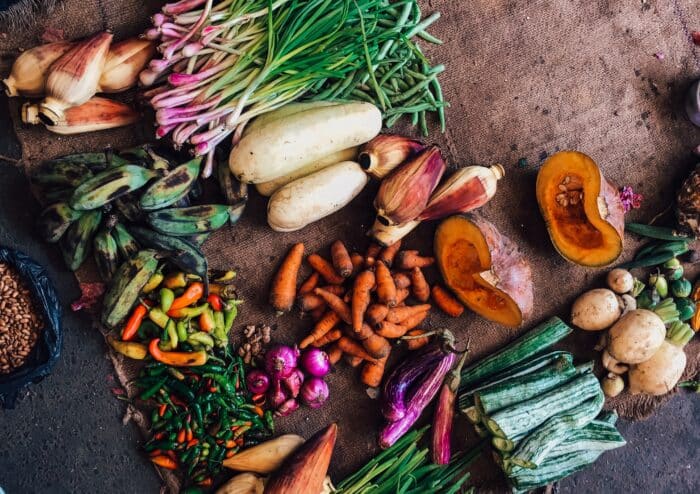
Restons optimistes…
La bonne nouvelle est que la majorité des canadiens et canadiennes sont motivés.es à agir contre ce fléau et à changer leurs habitudes alimentaires pour une consommation plus responsable. J’aime manger, pas gaspiller Canada a d’ailleurs mené une enquête en 2020 auprès de 1 200 Canadiennes et Canadiens et 94% se disent motivés.es à diminuer le gaspillage alimentaire dans leur foyer. Mais comment faire pour sauver ces bananes qui traînent sur le comptoir depuis des jours ou ces légumes qui approchent de leur pleine maturité?
3 stratégies pour consommer plus consciemment
1- Planifie tes repas
Es-tu le genre de personne qui fait son épicerie à l’improviste? Si c’est le cas, tu peux commencer par faire ta liste d’épicerie selon les ingrédients manquants dans ton frigo et garde-manger afin de limiter les achats inutiles. Et si tu veux devenir un.e pro de l’organisation, tu peux aussi planifier les repas de la semaine. Il suffit de prévoir approximativement les recettes que tu aimerais préparer avant de faire tes courses. Cette étape te permettra non seulement de limiter le gaspillage alimentaire, mais aussi de faire des économies.

2- Le frigo, ton meilleur allié
On ne t’apprend rien, pour conserver tes repas, il faut les garder au frais! Fruits, légumes, restes et produits laitiers, il est important de mettre chaque ingrédient dans le bon compartiment afin d’optimiser sa conservation et éviter qu’il finisse dans les poubelles.
Comme le montre l’illustration de J’aime manger, pas gaspiller Canada, sauvegarder ses aliments dans le congélateur est tout un art!
Tu peux même mettre des repas précuits au congélateur pour les sortir dans tes journées de grand rush.
3- Teste de nouvelles recettes
Limiter le gaspillage alimentaire ne rime pas uniquement avec planification de repas. Tu peux aussi t’amuser à tester de nouvelles recettes avec des fruits et légumes trop mûrs. Banana bread, gâteaux aux carottes ou encore pain aux courgettes, plein de recettes créatives et délicieuses te permettront de sauver ton surplus de fruits et légumes.
Alors? Penses-tu encore que le zéro-gaspillage est compliqué? Comme tu peux le constater, tout est une question d’organisation et de créativité!
Et d’ailleurs, si nos saucisses Gusta finissent dans ton frigo, il y a de fortes chances que tu les dévores en une seule fois (impossible de résister à nos produits riches en saveurs et en bons nutriments). Cependant, nous tenons à te rappeler qu’une fois l’emballage ouvert et mis dans une boîte hermétique, leur durée de conservation peut aller jusqu’à 10 jours. Si tu es à la recherche d’idées de recettes savoureuses à base de nos fameuses saucisses, dirige-toi vers notre section Recettes+.
Après avoir adopté une alimentation végane, plusieurs athlètes de haut niveau prouvent que la viande ou les produits laitiers ne sont pas nécessaires pour bien performer. Par le fait même, ils défient tous les mythes sur le véganisme. En effet, une étude du Journal of the International Society of Sports mentionne que le régime végane est riche en glucides, en fibres et en plusieurs autres nutriments. Les athlètes véganes bénéficient donc de tout le nécessaire pour pouvoir continuer à battre tous les records, peu importe la discipline !
Voici 9 athlètes végétaliens qui puisent toute leur énergie dans les plantes.
Meagan Duhamel
Après avoir lu un livre sur le véganisme en 2008, cette athlète de patinage artistique s’est tournée vers le végétalisme. Depuis, elle a remporté de nombreux titres prestigieux, dont la médaille d’or aux Championnats du monde de l’ISU en 2015 et en 2016, et aux Jeux olympiques de Sotchi en 2018. Elle mentionne que sa diète l’aide à rester focus sur la glace, à avoir plus d’énergie et à améliorer ses performances.

Morgan Mitchell
L’athlète olympienne de course, Morgan Mitchell, n’a plus besoin de présentation depuis les Jeux olympiques de 2016 à Rio de Janeiro. Elle y avait atteint la 7e position à l’épreuve des 4 x 400 mètres. Mitchell a adopté le régime végétalien en 2014 pour augmenter son niveau d’énergie. Elle a d’ailleurs fait une apparition dans le célèbre documentaire The Game Changers, dans lequel elle prône ce style d’alimentation.
Patrik Baboumian
L’un des hommes les plus forts de la planète donne tort à tous ceux qui clament qu’il faut manger de la viande pour bâtir une grande masse musculaire. Végane depuis 2011, il a remporté deux records Guinness en 2012 et deux records du monde en 2013. Il a d’ailleurs écrit un livre en 2015 sur sa transition alimentaire. VRebellion-1 : How to Become a Vegan Badass démontre tous les bénéfices que lui ont apportés le véganisme.
Lewis Hamilton
Depuis 2017, ce pilote automobile britannique ne jure que par une alimentation à base de plantes. L’athlète, qui a été couronné champion du monde de F1 à maintes reprises et qui possède de nombreux records dans le sport, utilise son image pour promouvoir les bienfaits du véganisme. Il a également initié son chien Roscoe à la diète végétalienne ! Hamilton mentionne que cela a grandement aidé l’animal à améliorer son état de santé.

Scott Jurek
Ultramarathonien végane, Scott Jurek défie tous les préjugés à propos du véganisme. Cet athlète, qui est une icône dans le monde de la course, a remporté plusieurs titres. Pour ne nommer qu’une seule réalisation, il détient le record des États-Unis dans la course de 24 heures. Il y a couru 165,7 miles (266,7 kilomètres), ce qui équivaut à 6,5 marathons. Et tout ça, en étant végane ! Il crédite le véganisme pour ses victoires, son endurance et sa capacité à récupérer rapidement après l’entraînement.
Kendrick Farris
Un haltérophile végane? Et oui! Depuis 2014, Kendrick Farris s’entraîne très fort et ne se nourrit que de plantes. Il participe aux Jeux olympiques depuis 2008, où il fait bonne figure en se maintenant dans le top 12 mondial. Il détient d’ailleurs le record américain depuis qu’il a soulevé un poids de 377 kg dans sa division. À tous ceux qui disent qu’il est impossible de manger suffisamment de protéines lorsqu’on est végane, il répond simplement qu’il est la preuve vivante que c’est tout le contraire!
Georges Laraque
Ce grand joueur de hockey québécois a fait partie de quelques équipes de la Ligue nationale de hockey depuis le début de sa carrière, en 1997. Il est retraité depuis 2010, mais continue de faire du sport amateur. Il a changé le cap vers une alimentation à base de plantes en 2009 et depuis, il parle de cette modification à son style de vie partout dans les médias. Il prône un effet positif sur sa santé globale, en plus d’une augmentation de son énergie et de son endurance.
Venus Williams
La célèbre athlète de tennis est devenue végétalienne après avoir été diagnostiquée avec le syndrome de Sjögren, une maladie auto-immune, en 2011. Suite à sa descente drastique aux classements, ce changement de diète lui a permis de remonter au top au fil des années. En plus de réduire l’inflammation causée par sa maladie, l’alimentation végane lui a donné la force et l’énergie de continuer sa carrière d’athlète. Elle a d’ailleurs récemment lancé sa propre marque de protéine végane, Happy Viking.

Kyrie Irving
L’un des joueurs vedettes de la National Basketball League, Kyrie Irving, est végane depuis 2017. Alors qu’il jouait pour les Celtics de Boston, il a décidé de modifier son alimentation. Cette année-là, il a d’ailleurs crédité les 13 victoires consécutives de son équipe à son changement de diète. Il insiste sur le fait que son alimentation végétalienne l’a aidé à devenir un meilleur athlète, en lui fournissant plus d’énergie et une plus grande habileté à récupérer.

C’est grâce à des sportifs et des célébrités comme celles-ci, qui ne se gênent pas de publiciser les bienfaits de l’alimentation végane, qu’elle prend de plus en plus d’expansion à travers le monde. Ces athlètes prouvent, une fois de plus, que se nourrir de plantes ne peut apporter que du positif!
Les produits GUSTA t’aideront à puiser toute l’énergie nécessaire pour devenir un grand athlète!
Depuis quelques années, les pâtisseries véganes ont la cote dans les villes de Montréal, Toronto et Vancouver. Les végétaliens qui ont la dent sucrée peuvent maintenant trouver de quoi satisfaire leur rage de sucre, presque peu importe où ils sont. Que tu préfères les cupcakes, les gâteaux, les croissants ou les muffins, les pâtisseries végétaliennes ont bien souvent des options pour tous les goûts.
Voici nos 9 meilleures adresses à Montréal, à Toronto et à Vancouver.
Montréal
Son extérieur de couleur rose bonbon ne passe pas inaperçu sur le boulevard Saint-Laurent, dans le Plateau-Mont-Royal. Et une fois à l’intérieur, les clients font la ligne en contemplant les présentoirs de produits qui se trouvent sous leurs yeux. Les choix de pâtisseries pleuvent : croissants, cupcakes, biscuits, tartelettes, et plus encore! Fraîchement préparées tous les jours, elles fondent en bouche. Et la cerise sur le sundae : Sophie Sucrée façonne également du chocolat et de délicieuses truffes. Une pause tout indiquée pour les rages de sucre.
Cette petite boutique qui a pignon sur la rue Gounod à Montréal, se trouve tout près du parc Jarry. Avec ses glaces véganes délicieuses à base de bananes et de chanvre, c’est un arrêt obligatoire avant d’aller se prélasser au soleil. Mais avant tout, Rawesome est surtout connu depuis plusieurs années pour ses gâteaux au fromage véganes faits à base de noix de cajou. Avec des saveurs telles que lime, chocolat, pacanes, crème brûlée et choco-framboise, il y a de quoi faire frémir tes papilles gustatives.
Audacieuse Vanille est l’une des pâtisseries véganes préférées des Montréalais. Ouverte depuis 2017 dans le Sud-Ouest à Verdun, cette petite boutique met de l’avant des produits 100% naturels. Armés de leurs plus grands secrets de pâtissiers, les propriétaires s’amusent d’ailleurs à changer le menu toutes les deux à trois semaines. Tu y trouveras les meilleurs brownies végans en ville, sans parler des petits gâteaux au citron et aux carottes!
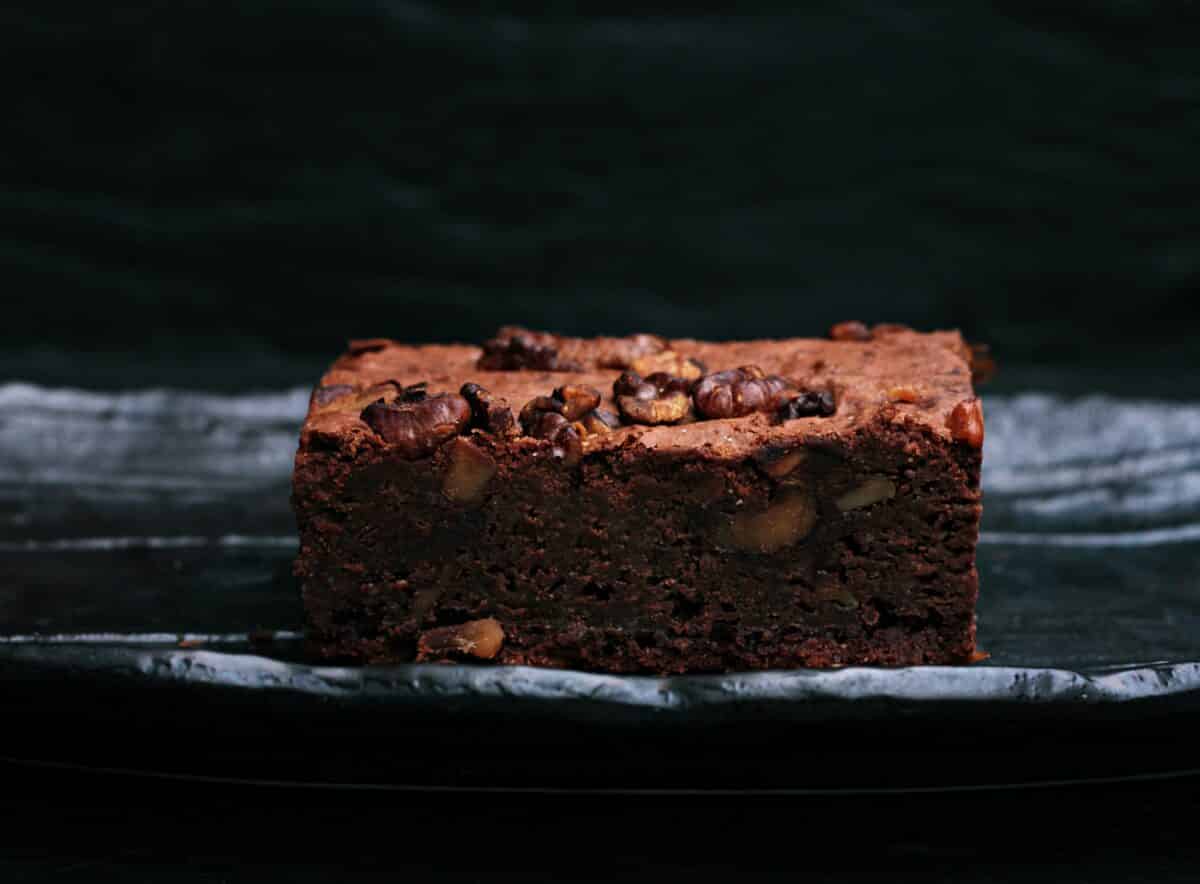
Vancouver
Cette pâtisserie porte son nom à merveille : les gâteaux y sont magiques (et le décor bleu poudre aussi). Passe les voir pour attraper un cupcake ou un délicieux biscuit en chemin, tu ne seras pas déçu. Ils sont aussi beaux qu’ils sont bons! Tous leurs produits sont préparés avec des ingrédients biologiques, locaux ou issus du commerce équitable. C’est donc faire d’une pierre deux coups : se délecter et encourager une entreprise qui se soucie de notre planète.
Sur la rue Broadway Ouest à Vancouver, se trouve cette mignonne petite boulangerie. Leurs choix variés de gâteaux, de brioches géantes et de scones, sans oublier de décadents brownies, mettront un peu de joie dans le cœur de chacun. Accompagnées d’un délicieux café, ces petites douceurs sont encore meilleures. Si tu es de passage dans la ville, Edible Flours doit faire partie de tes destinations à visiter!
De petites merveilles sucrées et véganes inspirées des recettes de la fine pâtisserie française se trouvent dans cette délicate boutique. La propriétaire est née en France et a décidé de faire profiter les Vancouvérois de ses talents culinaires pour les desserts, en commençant par ses fameux macarons aux saveurs variées! On y trouve également de délicieuses pâtisseries telles que des millefeuilles, des tartes au citron meringuées et des cannelés.

Toronto
Simplement à regarder leur magnifique présentoir coloré, tu auras la salive au coin de la bouche. La variété offerte dans ces deux boutiques de Toronto est inégalable. Bunner’s est particulièrement reconnu pour ses beignes véganes aux saveurs créatives et ses Josephine Louise qui imitent à la perfection (et encore mieux) ce que l’on connaît comme le Jos Louis. Original et délicieux : voici deux qualificatifs qui décrivent bien cette pâtisserie.
Directement située sur la rue Queen, voici une autre pâtisserie appréciée des Torontois. On voudrait goûter à tout si on le pouvait! Ouvert en 2012, cette boutique était l’une des précurseurs des desserts végans. Deux pour un : ils sont consciencieux de l’environnement et tentent de créer le moins de déchets possible. Les cupcakes, les beignes et les muffins font fureur, sans parler des barres sans cuisson, parfaites pour une petite collation.
Ce sont les rois des beignes! Toutes les pâtisseries sont cuisinées à la main tous les matins. C’est pourquoi la fraîcheur de leurs produits est toujours assurée. Les beignes fondent en bouche, les brownies sont moelleux à souhait et les gâteaux sont riches et magnifiques. Bloomer’s possède quatre locations dans la grande ville de Toronto. Tu peux donc faire un petit détour et leur rendre visite, peu importe où tu es.

Tu veux diminuer ta consommation de viande, voire la supprimer ? Tu n’es pas seul.e dans cette démarche ! L’alimentation végétale gagne de plus en plus en popularité et nous sommes plusieurs à apporter des changements dans nos assiettes. D’ailleurs, tous ceux qui ont fait la transition vers un régime végétarien ou végétalien ont sans doute déjà entendu cette phrase au moins une fois dans leur vie : « Tu n’as pas peur de manquer de protéines? ». Ce mythe est ancré dans nos croyances et pourtant, nombreux sont les aliments d’origine végétale qui sont riches en protéines !
Retour sur le guide alimentaire canadien
Faisons un saut dans le temps : en 2019, Santé Canada a publié un nouveau guide alimentaire mettant en lumière les protéines végétales. Dans la section « Consommez des aliments protéinés », on remarque que l’assiette n’est pas uniquement composée de viande, mais aussi de noix, de tofu et de légumineuses. Santé Canada recommande de diversifier ses apports en protéines et cite les légumineuses (comme les lentilles, les haricots et les pois), les boissons de soya enrichies, le tofu, les fèves de soya et les noix comme des aliments protéinés sains.
Sources de protéines végétales et idées de recettes
1. Les légumineuses
Ce n’est pas pour rien que les légumineuses sont les aliments chouchous de végés. Ces graines sont non seulement peu coûteuses, mais aussi riches en protéines ! De plus, les légumineuses sèches sont non périssables et ne prennent pas beaucoup de place dans la cuisine.
Les légumineuses comme les lentilles, les haricots ou encore les pois chiches sont versatiles et s’intègrent parfaitement dans de nombreuses recettes : hummus, ragoûts de légumes, soupes, salades, etc.
Par ailleurs, si tu as envie de tester de nouvelles recettes à base de légumineuses, on te propose le Dhal de la Cuisine de Jean Philippe.
2. Le tofu
Son goût neutre et sa texture peu commune lui confèrent une mauvaise réputation. Et pourtant s’il est préparé de la bonne façon avec des épices variées, le tofu devient très intéressant. Allié des végéta*iens, le tofu s’intègre parfaitement dans toutes les recettes sucrées et salées ! Cette versatilité revient justement à son goût neutre qui lui permet de se marier avec tous les assaisonnements. Grillé, cuit au four, mariné ou cru, le tofu se prépare de différentes façons et répond à tous les goûts. Une fois qu’on apprend à le cuisiner, on ne peut plus s’en passer !
À la recherche d’une idée de recette originale ? Le tofu magique de Loonie fera aimer le tofu à tous les membres de ta famille !
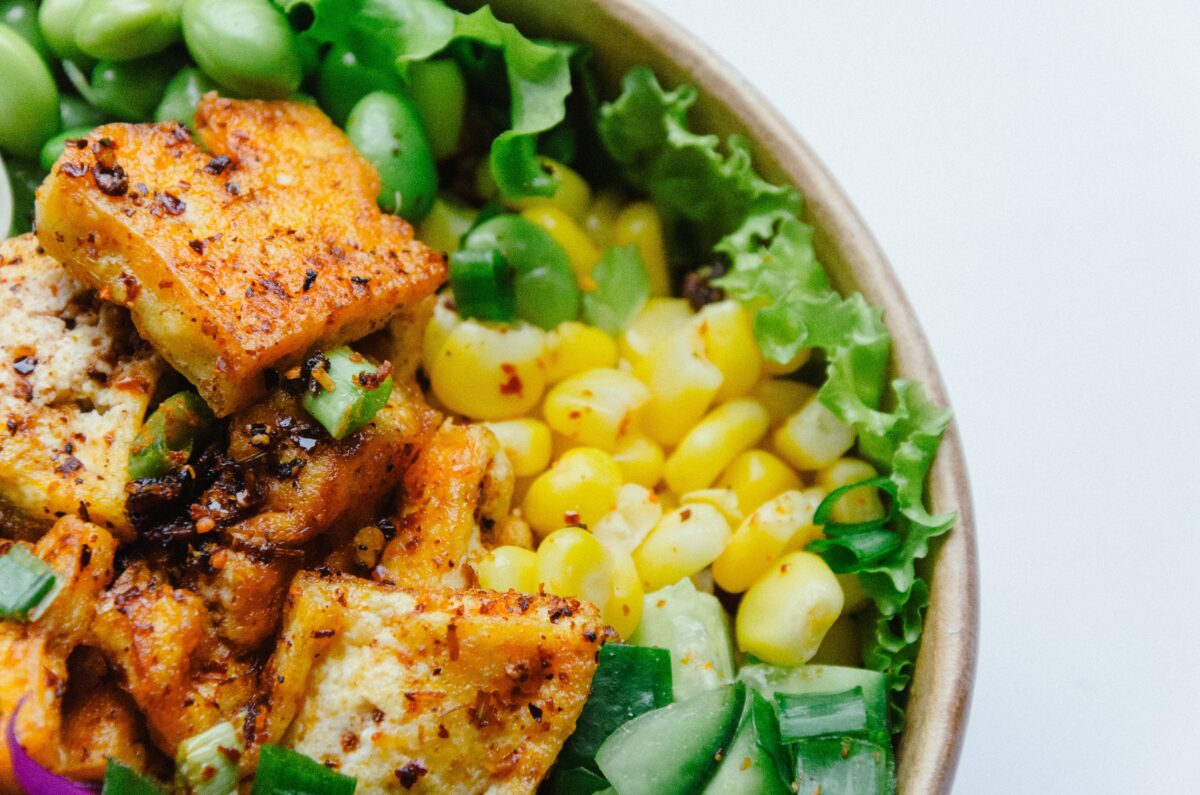
3. Le tempeh
Tout comme le tofu, le tempeh est fait à base de fèves de soya. Ceci dit, le tempeh se différencie par sa texture pâteuse et son goût fermenté. Originaire d’Indonésie, le tempeh se mange traditionnellement frit ce qui lui confère un aspect croquant et gourmand. Cependant, le tempeh peut être cuisiné de différentes façons : mariné, grillé, sauté, etc. Si tu comptes essayer pour la première fois le tempeh et que tu cherches une recette facile pour ne pas le rater, on te recommande le tempeh mariné à la sauce soya & au vinaigre balsamique de Trois fois par jour.
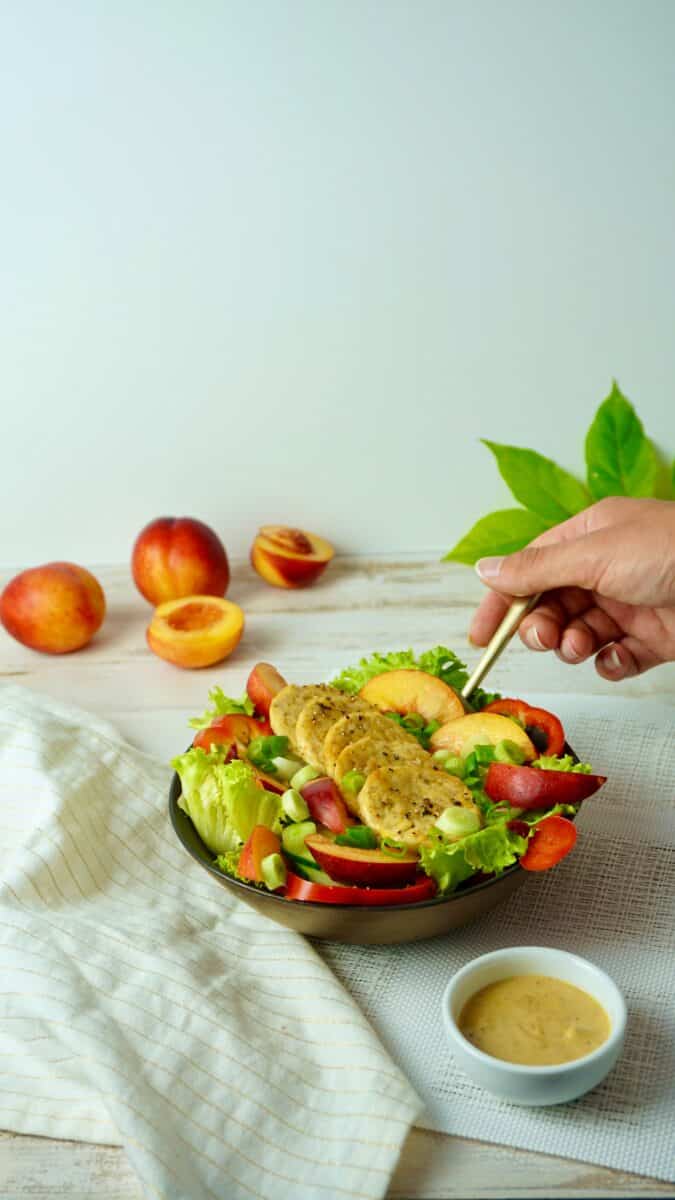
4. Le seitan
Le goût de la viande manque à tes papilles ? Le seitan va sans doute satisfaire tes cravings ! Cet aliment végétal a vu le jour en Chine il y a plus de mille ans et a été introduit par les moines bouddhistes afin de rendre la cuisine végétarienne accessible. Très riche en protéine et faible en gras, le seitan est un indispensable pour tous ceux qui veulent diminuer, voire supprimer leur consommation de viande. À titre informatif, 100 g de seitan cuit contient à peu près 20 à 30 g de protéines ! En bref, cet aliment brise tous les mythes concernant les carences alimentaires dans les régimes végétaliens.
Si tu veux te laisser tenter par le seitan, on te propose notre recette coup de cœur: le kebab grillé et riz safran. Tu peux aussi te laisser tenter par nos saucisses au seitan afin de faire le plein de protéines!
5. La PVT (protéine végétale texturée)
Envie de reproduire tes recettes classiques et réconfortantes à base de viande hachée? La PVT, qui est du soya déshydraté, te permettra justement de réinventer ces recettes en retrouvant la texture de la viande hachée! Polyvalente, faite à base de soya et économique, la PVT s’intègre parfaitement dans les recettes de Bolognaise végé, les tacos, etc.
Nous te proposons la recette de sauce Bolognaise végane de Ricardo pour t’initier à la PVT.
On espère que toutes ces recettes te permettront de faire le plein de protéines tout en faisant plaisir à tes papilles gustatives. N’hésite pas à partager l’article à tous ceux qui pensent que l’alimentation végétale est pauvre en protéines! Entre-temps, si tu veux découvrir plus d’aliments substituts de viande, sache que nos produits répondent à tous les goûts. Parmi notre large éventail de produits, nous comptons des saucisses véganes, des rôtis de seitan, du fauxmage, du pâté et bien plus encore! En gros, les produits Gusta te permettront de bien te préparer à la saison BBQ qui approche avec l’arrivée du soleil.
Ahh la fameuse question que l’on se pose lorsqu’on fait le virage vers une alimentation végétale ou bien que nos proches nous posent sans arrêt lors d’un souper… c’est tu végane ça ?
Pour vous sauver du temps à l’épicerie ou si vous souhaitez éduquer votre entourage à votre mode de vie végane, on répond à la question suivante :
C’est tu végane ça…
Le pain
Le pain est généralement composé de farine, eau, sel et levure. Donc oui, le pain c’est végane. À la seule exception des pains faits aux fromages ou contenant des morceaux de bacon, par exemple.
Les croissants
Ahhh les bons croissants de la boulangerie, ça sent tellement bon, mais ce n’est malheureusement pas végane, à moins que vous soyez dans une boulangerie végane ! Ils sont souvent faits avec du lait, du beurre et des œufs pour donner une texture croustillante.

Les jujubes
Les jujubes, c’est fait avec quoi au juste ? Lorsqu’on lit la liste des ingrédients, il en existe peu que l’on connaît et l’un des principaux que l’on est capable de lire c’est : la gélatine. C’est une substance fabriquée à partir de peau, tendon, ligament et os de vaches ou porc bouilli, eh oui.
La majorité des jujubes contiennent de la gélatine, c’est pourquoi ce n’est pas un produit végane, mais vous trouverez de plus en plus des options à base de fruit (pectine) ou sans gélatine dans vos épiceries et dépanneurs du coin !
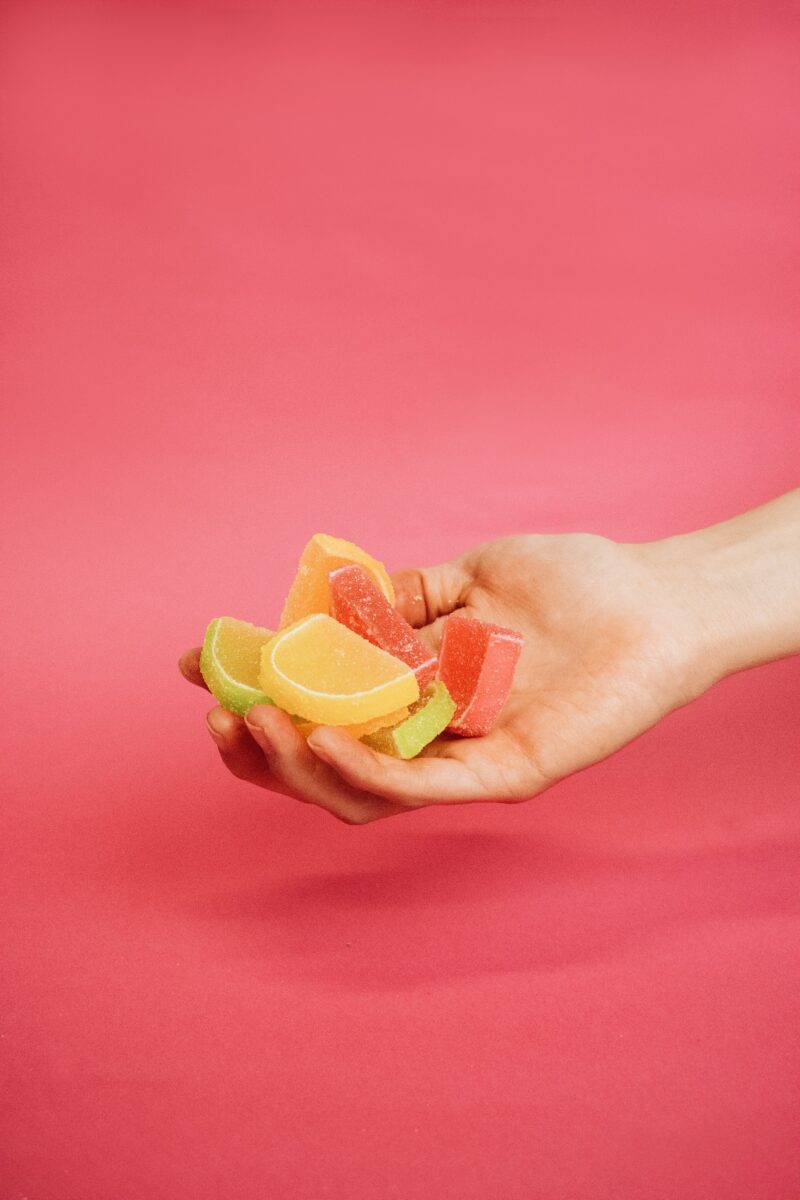
Le vin
Si on vous demande : est-ce que le vin c’est végane ? A priori vous répondrez bien évidemment, puisque c’est des raisins… mais c’est un peu plus compliqué !
En effet, des produits d’origine animale sont utilisés dans les méthodes de production et de conservation du vin, notamment lors du collage.
Le collage, c’est quoi ? C’est un procédé qui consiste à ajouter dans la cuve dans laquelle se trouve le vin, des protéines qui vont attirer les particules non désirées et/ou restants de levures. Les protéines utilisées peuvent être des blancs d’œufs, de la gélatine ou d’autres substances animales.
Alors non, le vin, ce n’est pas végane. Les seules exceptions sont les vins certifiés véganes, cela veut dire que les producteurs ont utilisé des alternatives au collage animal.
Les confitures
Pour les confitures, c’est assez simple !
Tel que mentionné pour les jujubes, si la confiture est aussi faite avec de la gélatine, la réponse est non !
Par contre, si la marque utilise de la pectine à la place de la gélatine, la réponse est oui !

La margarine
La plupart des margarines sont véganes, mais possèdent la mention « peut contenir des traces de produits laitiers ». Cela veut dire qu’elle a été produite dans une usine où l’on retrouve des produits laitiers, pas qu’elle en contient !
Alors… oui la margarine, c’est végane.
Avec toutes ces informations, nous espérons que ces informations vous faciliteront votre prochaine épicerie ou bien vous aideront à préparer un repas pour votre ami(e) végane !
Toute recette de pâtisserie peut être transformée en recette végétalienne. En fait, trouver des substituts végétaliens pour les recettes de pâtisserie sans compromettre le goût ou la texture est assez facile à faire une fois que l’on connaît les bases.
1. Beurre
Le beurre est sans aucun doute l’un des ingrédients les plus utilisés en pâtisserie. Il confère une richesse et une saveur incomparables à toutes vos confections. Heureusement, le beurre peut facilement être remplacé par une variété d’options à base de plantes.
- Si votre recette contient du beurre fondu, vous pouvez facilement le remplacer par de l’huile d’olive ou autre (comme de l’huile de canola, d’avocat ou d’arachide). Si la recette compte ½ tasse de beurre fondu, ajoutez simplement ½ tasse d’huile. Certaines huiles sont plus goûteuses que d’autres et peuvent enrichir la saveur de votre recette.
- Si vous avez besoin de beurre froid pour une recette, pour une pâte à tarte par exemple, utilisez une alternative de beurre végétalien froid. Les beurres végétaliens ont tendance à fondre plus rapidement que le beurre laitier, donc faites vite.
- Le beurre peut également être remplacé par de l’huile ou du beurre de noix de coco, des beurres de noix, de la purée d’avocat ou de la compote de pommes.
2. Oeufs
Les œufs sont parmi les ingrédients les plus importants en pâtisserie. Ils ajoutent structure et stabilité, humidité, richesse et volume aux recettes. Heureusement, il existe plusieurs options pour remplacer les œufs dans une recette.
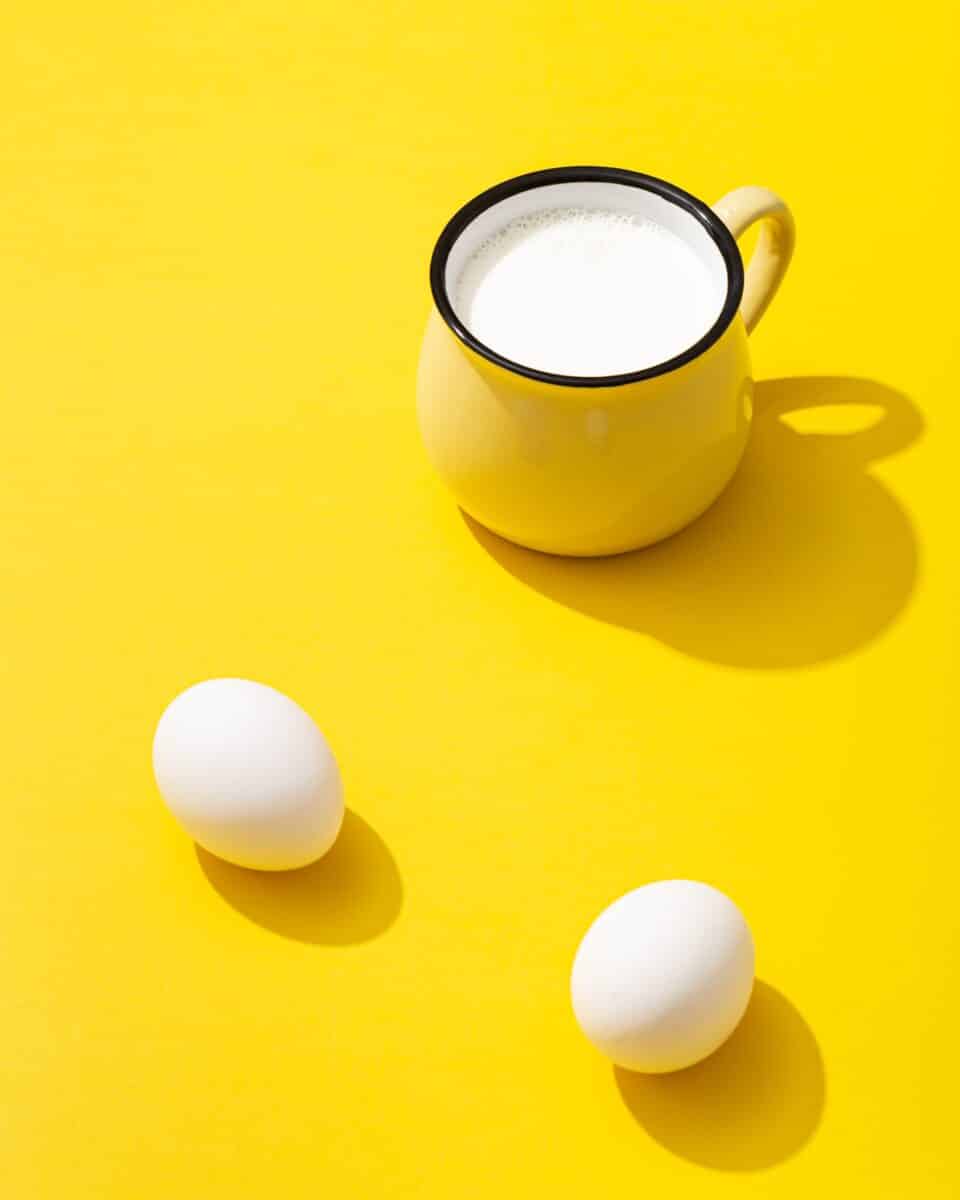
- Un œuf entier peut être remplacé par un « œuf » de graines de lin ou de chia. Mélangez simplement 1 cuillère à soupe de graines de chia ou de lin avec 3 cuillères à soupe d’eau. Laissez reposer le mélange jusqu’à ce qu’il se gélifie, ce qui signifie qu’il est prêt à être utilisé. Si vous devez remplacer plus de 3 œufs dans une recette, il est conseillé d’utiliser 3 œufs de chia ou de lin et de remplacer le reste par l’une des alternatives citées ci-dessous.
- Si la présence d’œufs dans votre recette est simplement pour ajouter de l’humidité, vous pouvez les remplacer par du tofu soyeux fouetté (¼ tasse par œuf), de la purée de banane (une banane moyenne par œuf) ou de la compote de pommes non sucrée (¼ tasse par œuf). La banane et la compote de pommes sont déjà sucrées, donc vous pouvez réduire la quantité de sucre dans votre recette.
- Les blancs d’œufs fouettés dans les meringues et les mousses peuvent facilement être remplacés par de l’aquafaba, le liquide dans lequel les pois chiches en boîtes sont conservés. Égouttez vos pois chiches et fouettez le liquide jusqu’à l’obtention de pics mous ou fermes comme vous le feriez pour monter des blancs d’œufs en neige. Vous pouvez ajouter du sucre à votre garniture fouettée. Un blanc d’œuf équivaut à environ 3 cuillères à soupe d’aquafaba.
- Si aucune de ces options ne vous plaît ou ne convient à votre recette, des substituts d’œufs végétaliens commerciaux sont également disponibles.

3. Lait
Les protéines de lait ajoutent de l’humidité et de la saveur aux pâtisseries. Les recettes précisent souvent du lait entier comme ingrédient car la matière grasse ajoute également de la richesse. Le lait contribue aussi à donner aux produits de boulangerie leur couleur dorée.
- Remplacez le lait de votre recette par du lait végétal de votre choix dans une proportion de 1 pour 1. Certains laits à base de plantes comme l’avoine, le riz et le soja sont idéaux car ils ont un goût plus neutre. D’autres, comme le lait de coco, donneront leur saveur particulière à votre recette.
- Les laits à base de plantes peuvent contenir du sucre ajouté, donc la quantité de sucre dans votre recette peut être ajustée.
- Il existe une variété de laits à base de plantes avec une teneur en matière grasse différente, allant des produits écrémés à ceux contenant un pourcentage de gras plus important. La plupart des recettes demandent généralement du lait entier, qui doit être remplacé par une option contenant une teneur similaire en matières grasses.
4. Crème, yogourt, crème sure ou lait évaporé
L’ajout d’un ingrédient crémeux à une recette de pâtisserie se fait pour plusieurs raisons. Celui-ci peut ajouter un goût sûr, de l’humidité, de la texture, de la légèreté et / ou de la richesse à la recette.
- La crème de noix de coco non sucrée est un bon substitut 1 pour 1 de la crème laitière. On peut même la fouetter comme de la crème ordinaire. Si vous aimez le goût de la noix de coco, n’hésitez pas à l’ ajouter à votre recette. Elle peut même rehausser le goût de certaines recettes à base de fruits.
- La crème de noix de cajou a un goût plus neutre et plus riche, et peut être facilement préparée à la maison. Faites tremper une tasse de noix de cajou dans 1 ½ tasse d’eau pendant environ 30 minutes, puis mélanger jusqu’à l’obtention d’une consistance lisse.
- Les crèmes et les yaourts non laitiers sont, bien entendu, également disponibles partout dans une variété de saveurs et de pourcentages de matières grasses.
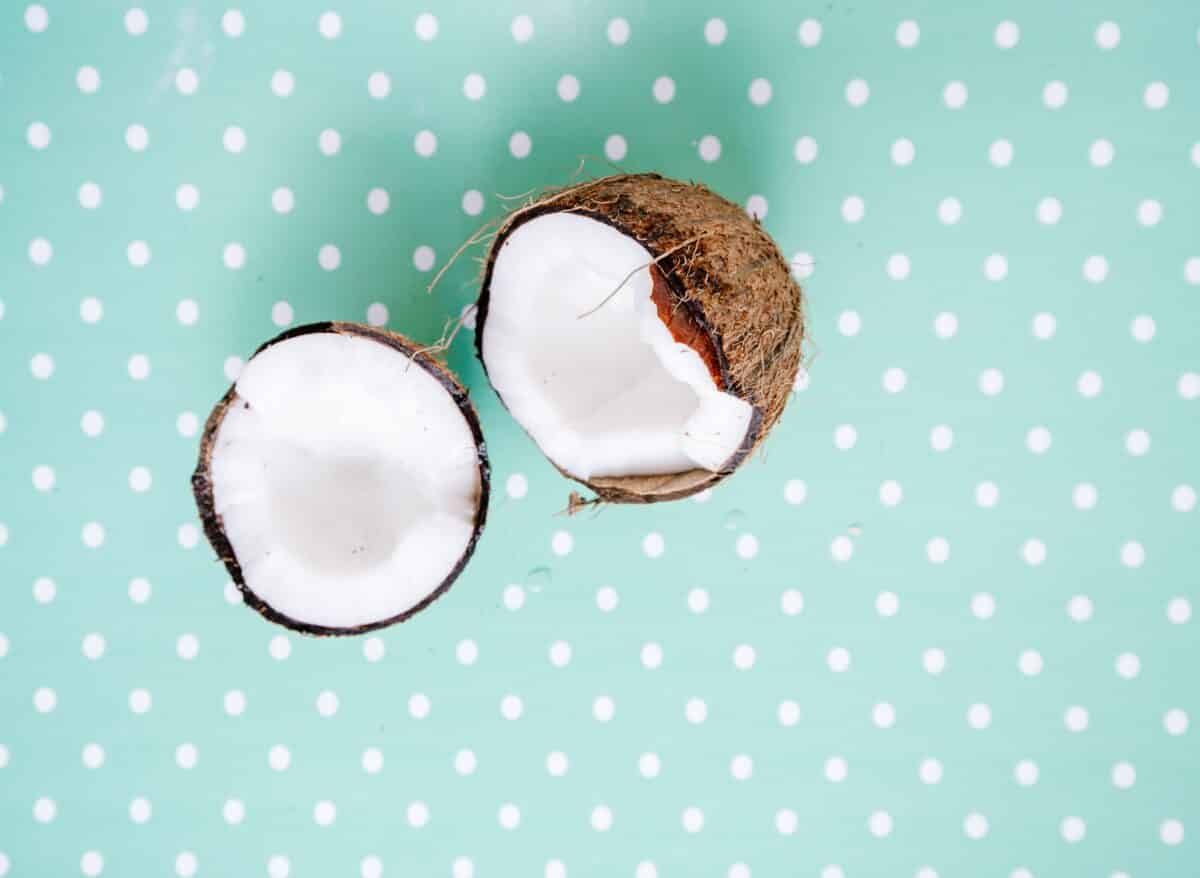
5. Babeurre
Le babeurre est le liquide restant après le barattage du beurre. L’acide lactique du babeurre réagit avec le bicarbonate de soude dans une recette pour créer un effet levant. C’est à cause de cette réaction que le babeurre ne peut être simplement remplacé par du lait dans une recette.
- Le babeurre est un ingrédient commun de la pâte à crêpes et de certaines pâtisseries. Il peut facilement être préparé à la maison en mesurant 1 cuillère à soupe de vinaigre ou de jus de citron dans une tasse à mesurer, puis en remplissant la tasse avec du lait végétal. Remuez et laissez reposer le mélange pendant 10 minutes et il est prêt à être utilisé ! Facile !
6. Miel
On a tendance à penser que le miel est un ingrédient végétalien, pourtant il ne l’est pas puisqu’il est produit par des abeilles.
- Le miel peut être facilement remplacé par du sirop d’érable, d’agave ou de maïs dans une proportion de 1 pour 1.
Il existe également de nouveaux produits commerciaux qui sont des « miels » végétaliens. Le goût ressemble tellement à du vrai miel, c’est bluffant!
Chez GUSTA, l’une de nos valeurs est le respect de l’environnement. Alors ce mois-ci, nous parlons de la mobilisation de la jeunesse, à échelle internationale et nationale, pour des causes environnementales et éthiques. Nous réalisons que la jeunesse prend la parole et n’a jamais été aussi engagée. Grâce à Internet et les réseaux sociaux, elle peut s’exprimer davantage et jouer de la force du collectif pour s’unir.
1- Au niveau mondial.
Ces dernières années ont été marquées par des grèves scolaires ayant lieu dans le monde entier pour agir face à l’urgence climatique. L’initiatrice de ce mouvement s’appelle Greta Thunberg. Cette adolescente suédoise, aujourd’hui âgée de 18 ans, est reconnue mondialement pour son activisme contre le changement climatique. En août 2018, elle fait parler d’elle, du haut de ses 15 ans, en brandissant une pancarte devant le Parlement suédois : « Grève scolaire pour le climat ». Elle décide de faire l’école buissonnière et de brandir cette pancarte chaque vendredi. Action que l’on appellera ensuite « Fridays for future » (Vendredis pour le futur). Greta inspire des milliers de jeunes dans le monde ce qui aboutit à de nombreuses grèves étudiantes dans les rues de dizaines de villes.

Quelques mois plus tard, en décembre 2018, plus de 20 000 étudiants ont participé à ces grèves, dans pas moins de 270 villes à travers le monde. Nous retrouvons ces mouvements notamment en Australie, France, Autriche, Belgique, Canada, les Pays-Bas, Allemagne, Finlande, Danemark, Japon, Suisse, Royaume-Uni et États-Unis.
Un an plus tard, il y aurait eu, selon The Guardian, un total de six millions de jeunes manifestants depuis le début du mouvement.
2- Au niveau national.
Concernant les mouvements nationaux, les jeunes Canadiens sont aussi très engagés. Lors de cette fameuse semaine de grève climatique, des rassemblements ont eu lieu dans près de 100 villes canadiennes.
Le Québec enregistre d’ailleurs une mobilisation record, entre 300 000 et 400 000 personnes réunies pour cet événement à Montréal. Ce rassemblement a été le plus important au monde dans le cadre de cette journée de grève mondiale pour le climat. Elle a aussi été qualifiée de « La plus importante manifestation de l’histoire du Québec », selon les organisateurs.
En Ontario, c’est le groupe « Friday for future Toronto » qui mène la marche de la journée du climat, encouragé par Greenpeace. De nombreuses organisations sociales, artistiques et environnementales emboîtent aussi le pas.

Côté ouest canadien, en Colombie-Britannique, près de 10 000 manifestants étaient attendus à Vancouver, co-dirigés par des jeunes comme Lilah Williamson, co-organisatrice de la manifestation de Vancouver et élève de 10e année. Elle prend la parole et demande aux décideurs du changement climatique d’agir. « Au Canada, on fait ça selon le concept du « die-in » pour symboliser les choses qui peuvent arriver si on ne crée pas vraiment des actions sur les changements climatiques », précise l’adolescente Lilah Williamson. Elle fait partie d’un des nombreux groupes de jeunes luttant contre le réchauffement climatique. Le sien, c’est les Sustainabiliteens https://sustainabiliteens.org/
Laina Burns, une autre jeune manifestante de 16 ans, exprime sa hâte de voter car elle souhaite voir des actions précises dans les politiques environnementales du Canada.Cette jeune comme beaucoup a de fortes convictions environnementales et politise déjà sa façon de vivre et de consommer. “J’essaie de ne pas utiliser les sacs en plastique. J’essaie de ne pas manger de viande. » dit Laina Burns.
Et oui, devenir végétarien ou végane est intimement lié à l’environnement. C’est effectivement l’une des causes majeures.
3- Les collectifs véganes à travers le Canada.
Dans ce point 3, nous avons décidé de mettre un petit accent sur les mobilisations liées au véganisme au Canada.
On recense en effet, des dizaines et des dizaines de groupes de jeunes mettant en exergue le véganisme, qui pour la plupart protègent aussi la planète et le respect des animaux.
Sur les réseaux sociaux, des communautés se créent et se consolident partout dans le pays. Il y a d’ailleurs de nombreuses communautés Facebook. En voici une liste non exhaustive :
- Festival végane Montréal 23k
- Association végane Montréal 23k
- Végane Montréal 15,1k
- Vegan Vancouver 3,7k
- Vancouver vegan 9,0k
- Vegans of Victoria 4,9k
- Ottawa vegetarian and vegan 8,3k
- Toronto vegans 17,3k

Les jeunes s’expriment et s’unissent autour de causes éthiques qui font du bien la planète. Comme le dit si bien Sylvain Charlebois, directeur scientifique de l’Institut de recherche en analyse agroalimentaire: “C’est un mouvement, ce n’est pas juste une mode. Ça va rester.”
On risque encore de parler d’eux et nous on aime ça !
Le seitan, ça te dit quelque chose ?
Aliment reconnu dans l’alimentation végétale, on a décidé de te donner pleins d’informations concernant cet ingrédient super protéiné : le chouchou de GUSTA !
Voici un petit questionnaire pour tester tes connaissances « Seitanistes. »
1- C’est quoi exactement le seitan ?
Il est issu de la protéine principale du blé, plus communément appelé gluten de blé. En effet, le blé est composé de plusieurs éléments. Citons les 4 principaux :
- L’enveloppe du grain de blé donne le son.
- Les diverses protéines d’où provient le gluten de blé, soit le seitan.
- L’albumen farineux, tissu de réserves de la graine dont l’amidon est issu.
- Le germe.
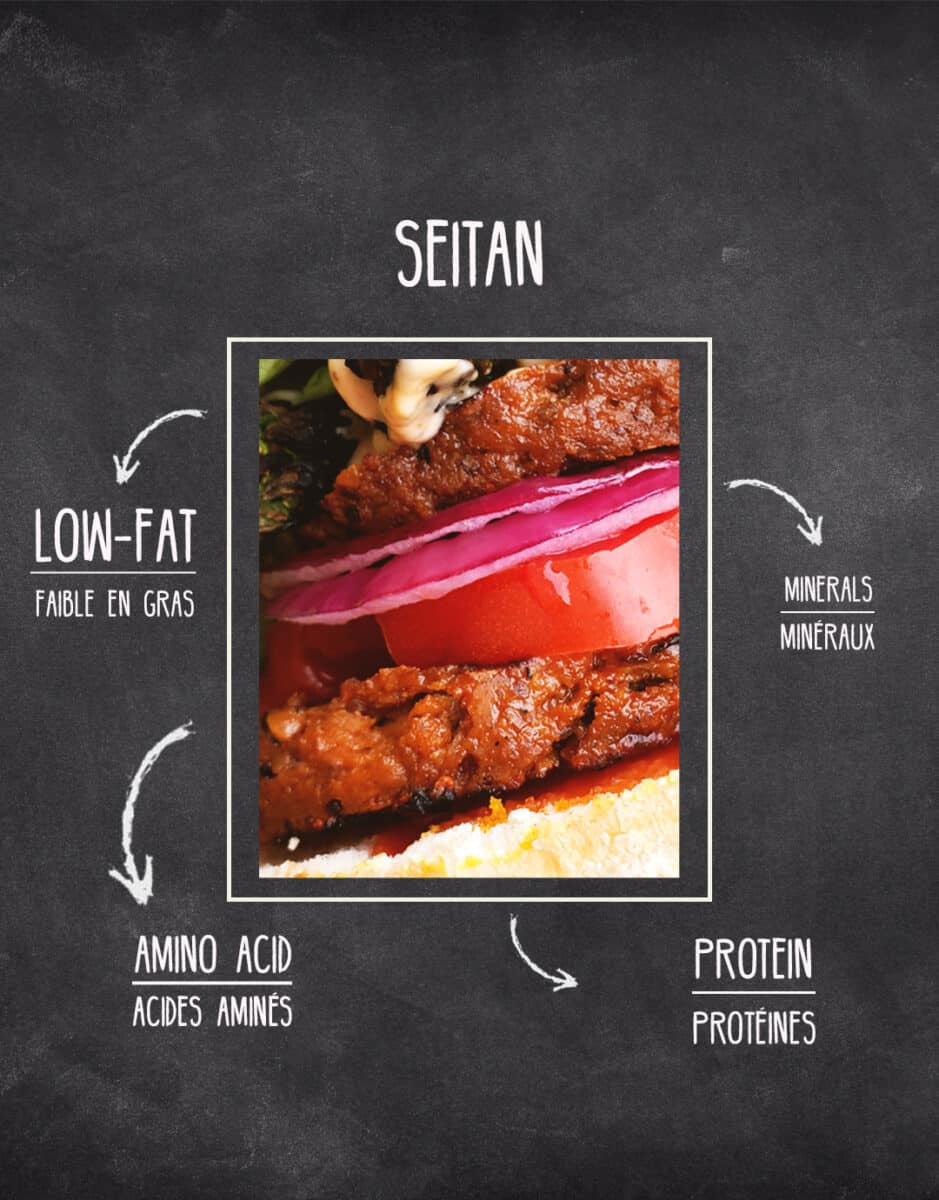
Le gluten est composé de plusieurs protéines, insolubles dans l’eau. On le retrouve dans différentes graines : l’orge, l’épeautre et le blé par exemple. D’ailleurs, tu peux faire une petite expérience à la maison : prendre une tasse de farine de blé, faire une boule avec un peu d’eau, la placer dans un chinois et la rincer abondamment sous l’eau. La masse restante que tu obtiendras sera un peu grisâtre, c’est le fameux gluten.
Mais soyons honnête, nature, le seitan a beaucoup moins d’intérêt. Dans la cuisine courante, le seitan est souvent aromatisé à partir d’épices et de légumes, comme sait si bien le faire GUSTA.

2- Connais-tu l’origine du mot seitan ?
Parlons peu, parlons histoire.
Inventé il y a plus de 1000 ans en Asie par des moines bouddhistes, le seitan a été popularisé dans la cuisine chinoises et japonaises.
Le nom “seitan” a été inventé dans les années 60 au Japon par Georges Ohsawa, le fondateur du régime macrobiotique.
Petit rappel sur le régime macrobiotique : Il serait le fait de trouver un équilibre parfait de l’énergie entre le yin et le yang dans notre alimentation, puisque selon M.Ohsawa, les aliments auraient des charges énergétiques. Bien entendu, ce concept est bien plus ancien. Hippocrate, père fondateur de la médecine moderne citait dans ces récits « Que l’aliment soit ton médicament ».
Seitan signifie « composé de protéines » (notre explication du dessus prend tout son sens). On le prononce d’ailleurs «say-tan».
Maintenant que tu connais l’origine du seitan, nous pouvons passer à notre point 3 qui concerne ses fameuses vertus nutritives.
3- On vante souvent les avantages nutritifs du seitan. Les connais-tu ?
- Le seitan est sans doute l’un des aliments végétaux le plus riche en protéines. Il est d’ailleurs appelé « wheatmeat » par les anglais, c’est-à-dire viande de blé.
Pour une portion de 100 g, le seitan cuit compte entre 25 à 30 g de protéines.
Pour te donner un ordre d’idée, le tofu en contient seulement 8 à 12 g.
Si on compare cela à la viande : 100g de viande rouge = 15/20g de protéines.
Alors seitan bouche un coin ?
- Le seitan est aussi un très bon apport en acides aminés. Il contient la quasi-totalité des acides aminés essentiels et en bonne quantité, presque 4 fois plus que le tofu. Excellent pour notre organisme !
Le saviez-vous ? Les acides aminés essentiels sont nommés de la sorte puisqu’ils ne sont pas synthétisés par le corps. Il est donc primordial de les lui apporter par l’alimentation. Il y a 9 acides aminés essentiels sur 20 au total. Les voici : L’histidine (essentiel pendant l’enfance et la grossesse), l’isoleucine, la leucine, la lysine, la méthionine, la phénylalanine, la thréonine, le tryptophane et la valine.
- Le seitan est aussi faible en matière grasse, il s’avère être un beau substitut de la viande. Il a cependant très peu de fibres.
- Le seitan regorge de minéraux comme le calcium, le magnésium, le fer et le phosphore.

4- Comment faire son propre seitan ?
Comme le tofu, pour faire son propre seitan, cela demande de la technique et de l’huile de coude.
Le seitan est fabriqué à partir de farine de blé. Nous y ajoutons un peu d’eau pour éliminer l’amidon, le son et autres protéines hydrosolubles. Il vous restera un morceau de gluten (insoluble à l’eau), autrement dit une pâte élastique. Cuite, elle donnera le fameux seitan. Comme précisé précédemment, le seitan est très fade sans épices, on ajoute donc de l’assaisonnement pendant les étapes de réalisation.
5- Quelles sont les différentes façons de cuisiner le seitan ?
Ce produit a une versatilité incroyable qui permet de réaliser un grand nombre de recettes ! Chez GUSTA, nous l’avons compris depuis longtemps. Nos saucisses et rôtis sont faits à partir de seitan. Nous avons travaillé afin d’obtenir un parfait équilibre des ingrédients dont nous avons le secret. Résultat : des produits savoureux avec une texture moelleuse et mordante.
Nous avons aussi travaillé au mieux pour réaliser des recettes avec le seitan sous toutes ses formes ???? :
- En lamelles : la pita au kebab végane Shawarma, https://gustafoods.com/recettes/recettes-fouineux/pita-kebab/
- Sous forme de steak : le burger KLT, https://gustafoods.com/recettes/klt-kebab-laitue-tomate/
- En cubes : Les épinards en folies, https://gustafoods.com/recettes/recettes-el-presidente/epinards-en-folies/
- Haché : Les nachos aux saveurs mexicaines, les sopes ou encore les lasagnes.
Alors c’est un 5 sur 5 ? On espère quand même que cet article t’aura appris des choses sur notre cher seitan. ????
Et si on repartait sur de bonnes bases en ce début d’année 2021 ?
2020 a été une année compliquée et on a tous envie de se réinventer et de renouveau !
Alors, on te propose 5 bonnes résolutions. Elles sont faciles à réaliser et bénéfiques pour ton moral et notre planète. On les a organisés dans l’ordre de facilité d’exécution.
1- Trier sa boite de courriels
Organiser sa boîte de courriels, c’est comme faire un bon ménage de printemps. Tu te sens tout léger après. Et puis, c’est vraiment bon pour la planète !
Pour rappel : la pollution numérique émet autant de gaz à effet de serre que l’aviation civile… Ce sont des milliers de serveurs qui chauffent pour traiter nos courriels. Si 50 000 internautes effacent 1000 emails de 1Mo, cela ferait 300 tonnes de CO² soit 300 Aller-retour PARIS-NEW YORK…
Tu peux commencer par supprimer tes vieux mails, photos et vidéos et trier des infolettres. On te donne ici un site super pratique pour te débarrasser de tes infolettres inutiles : https://www.cleanfox.io/en/
Ensuite, tu peux même organiser tes courriels restants dans des dossiers.

2- Sortir prendre l’air et redécouvrir sa ville
Le soleil se couche tôt, il fait froid et notre corps aimerait juste rester sous une couverture. Mais il faut bien que tu penses à bien t’aérer l’esprit. Puis à -10 degrés ça rafraîchit les idées, on te l’assure ! Alors prends-toi un 30min par jour, par exemple, pour aller te promener. Après le dîner, avant le souper, après le souper… Il y a pleins d’opportunités pour sortir dehors ! Il faut juste s’accorder du temps.
Tu penses connaitre ton quartier par cœur ? Allez, on t’aide un peu. L’application mobile Geocaching ça te parle ? Si tu ne connais pas, le principe est simple. A l’aide de ta position GPS, tu dois retrouver des trésors (messages et objets) dans ta ville. Une fois le trésor trouvé, tu peux déposer un objet ou un message et le remettre discrètement à sa place. Il y en a des millions dans le monde et sans doute quelques-uns autour de chez toi. ????
3- Manger local, de saison et végétarien 1x/semaine
Tu peux très bien te fixer des objectifs progressifs, genre 1 fois par semaine, tu essaies de manger des produits 100% canadien et de saison. Attention, tu risques de te prendre très vite au jeu après avoir goûté à tous ces produits locaux. D’ailleurs, on réalise chaque début du mois sur nos réseaux sociaux, un calendrier de fruits et légumes saisonnier et local pour t’aider à réussir ce défi !
Tu peux aussi retrouver des recettes véganes sur notre site internent pour t’inspirer : https://gustafoods.com/recettes/
4- Cuisiner un repas anti-gaspillage
On a toujours des restes qui traînent dans notre frigo mais avouons-le, ce n’est pas toujours facile de trouver l’imagination pour réaliser des recettes avec des légumes moches et une vieille sauce tomate. On a tous en tête un repas assez triste et sans saveur… ET pourtant, tu as pleins de façons de réaliser des plats anti-gaspillage délicieux. L’inspiration ne manque pas sur internet. On aime beaucoup cette application d’ailleurs, qui te propose des recettes avec tes restes du frigo : https://www.frigomagic.com/fr/
Ou encore, tu as Florence-Léa Siry avec son blogue Chic frigo sans fric : https://chicfrigosansfric.com/

5- Faire une activité inhabituelle 1x/mois
Qui dit hiver, dit nouvelle activité. Tu es plutôt attiré(e) par le sport ? Pourquoi tu n’essayerais pas de te mettre au ski, au snowboard, aux raquettes, au patinage ou encore à la luge ?
Pour favoriser la seconde main, tu peux même trouver ton équipement sur des sites de vente d’occasion comme sur Kijiji ou encore le marketplace de Facebook.
Tu préfères rester au chaud ? Pleins d’activités s’offrent à toi.
- Apprendre à dessiner ou à peindre.
- Réaliser ses savons soi-même.
- Faire du macramé pour redécorer un peu son intérieur.
- Broder un t-shirt blanc qui traine dans ton placard et le personnaliser.
- Se créer un petit jardin à l’aide de cagettes en bois ou d’une vieille échelle.
- Trier ses milliers de photos sur son smartphone, en faire une sélection et les faire tirer sur papier.
Petit bonus : Pourquoi tu ne tenterais pas de réaliser un igloo dans ton jardin ? ????

On espère que cet article t’a un peu inspiré pour bien commencer cette nouvelle année.
En tout cas, toute l’équipe GUSTA te souhaite une très belle année pleine de bonheur et qu’elle t’apporte paix et santé. ????
Parce qu’on aime partager un bon repas avec ceux qu’on aime, pour essayer de nouvelles recettes, pour réduire son empreinte carbone… il existe mille et une bonne raisons d’aimer (voire d’adorer) les produits GUSTA ! Si tu ne le connais pas encore, découvre maintenant quel est ton profil GUSTA !
Nous, ce qui nous anime chez GUSTA, c’est se faire plaisir et savourer un délicieux repas en famille ou une bonne fondue entre amis (et oui ça y est, c’est la saison!) tout en respectant l’environnement et les animaux ! Et toi ? Qu’est-ce que tu aimes ? Dis-nous pourquoi tu consommes nos produits et nous te dirons qui tu es !
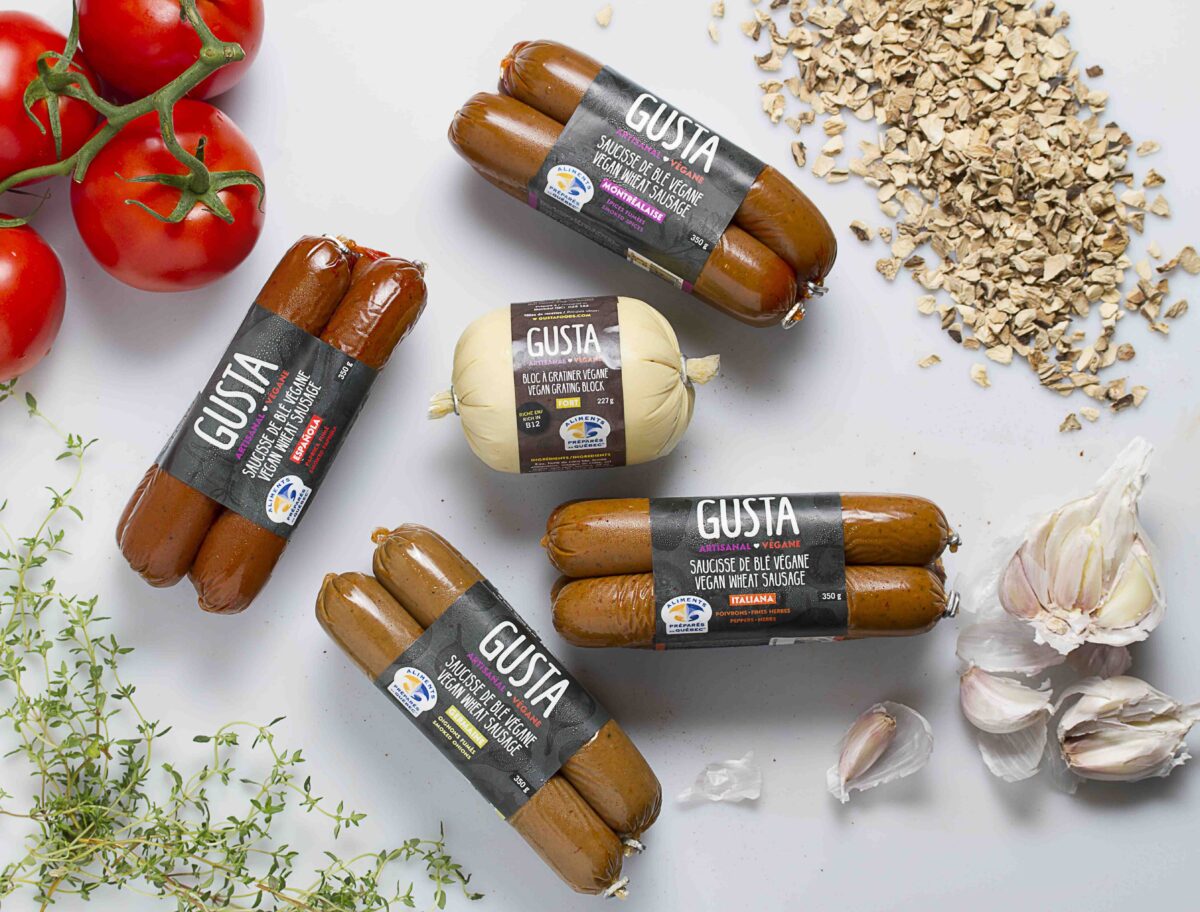
Le Fouineux
Autour de toi, tu entends de plus en plus parler de la cuisine végane et cela a piqué ta curiosité. Tu voudrais donc la découvrir mais tu ne sais pas par où commencer. Malgré cette envie de nouveautés, tu restes très attaché(e) à tes habitudes de cuisine, ou bien tu aimes la simplicité et tu te dis que cuisiner végane = cuisiner compliqué. La cuisine végane ne serait-elle donc pas faite pour toi ? Détrompe-toi ! La cuisine végane est pour tout le monde. Elle peut être super simple, rapide et surtout … délicieuse ! Ne t’inquiète pas. GUSTA sera là pour te guider sur la voie de la cuisine végane simple. Pour toi, le fouineux, nous avons dans notre répertoire une multitude de recettes qui te permettront de découvrir de nouvelles choses sans pour autant sortir de ta zone de confort. Ainsi, tu pourras continuer à manger et cuisiner les recettes que tu aimes en version végane.
Le Rebelle
Selon toi, les enjeux environnementaux sont cruciaux et tu as décidé de passer à l’action pour contribuer au mouvement. Tu penses que la réduction du gaspillage alimentaire et de l’empreinte carbone commence dans notre assiette. Et tu as bien raison ! Chez GUSTA, nous partageons tes valeurs et tes principes. C’est pourquoi, afin de t’aider dans ta lutte pour un meilleur environnement et une plus grande justice sociale, nous te proposons un large éventail de recettes. Ainsi, toi le rebelle, tu vas devenir le « Che de la fourchette » avec notre aide. Bien sûr, nous t’encourageons à les partager avec tes proches pour rallier d’autres partisans à ta cause. En effet, ces recettes étant véganes, elles contribueront à la réduction de l’empreinte écologique sans pour autant oublier le plaisir dans l’assiette. En d’autres mots, nous te proposons des recettes à la fois conscientes et délicieuses.
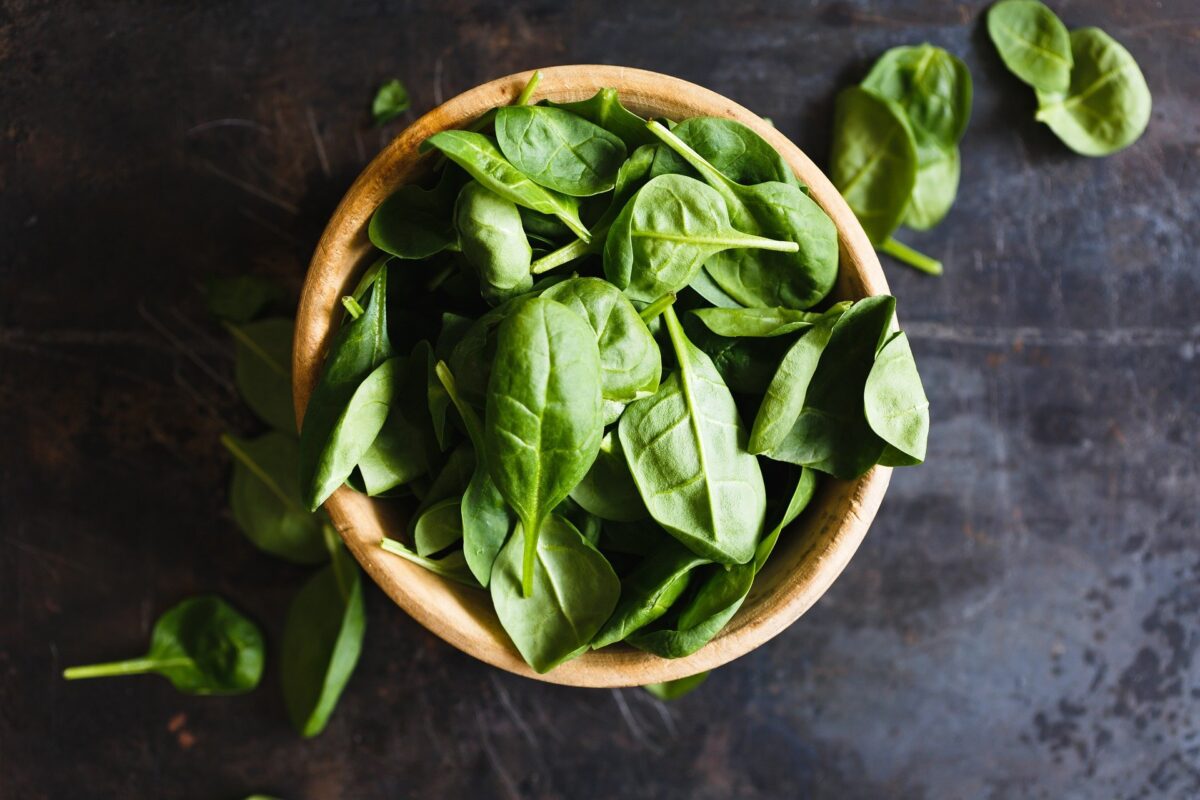
El Presidente
Tu maîtrises tous les codes de la cuisine végane. Matin, midi, soir, 3 fois par jour, 7 jours par semaines, tu vis, penses et cuisines végane. Tu es un peu comme l’élève modèle : tu as compris que tu pouvais apprécier la bonne bouffe tout en respectant l’environnement et les animaux. Seulement, tu penses déjà tout connaître de la cuisine végane et avoir tout goûté. Serais-tu à la recherche de nouvelles inspirations ? Aimes-tu les challenges derrière ton four et ta planche à découper ? Si la réponse est « OUI ! », alors chez GUSTA nous avons ce qu’il te faut. Nous avons tout un registre de recettes qui mettront tes skills d’El presidente à rude épreuve. Une chose est sûre, tu n’as pas fini de t’amuser avec nous ! Nous allons t’aider à avoir de nouvelles sources d’inspirations véganes : du petit-déjeuner au souper en passant par le dîner.
Alors ? A quel profil appartiens-tu ? Es-tu le Fouineux qui souhaite s’essayer à la cuisine végane sans abandonner ses recettes préférées? Le Rebelle qui consomme végane pour sauver l’environnement? Ou bien El Presidente en recherche constante de nouvelles inspirations et de nouveaux challenges? Parce que chez GUSTA, nous sommes aussi pour le partage, nous t’invitons à aller découvrir les recettes des autres profils pour toujours plus de nouveautés et de délicieuses recettes! N’oublie pas que comme toi, nous aussi nous sommes curieux et toujours à la recherche de nouvelles inspirations ! Nous aidons chaque jour notre communauté mais nous comptons aussi sur vous ! Oui, VOUS, derrière votre écran, vous êtes notre source d’inspiration ! Vous souhaitez apporter votre pierre à l’édifice ? Nous vous rappelons qu’à tout moment vous pouvez nous partager vos créations GUSTA !
Comme l’alimentation végétalienne, la mode végane se veut sans cruauté animale. Pas de cuir, de fourrure ou de laine au menu: des fibres végétales, des étoffes recyclées et des matières hi-tech prennent plutôt le pas sur les matériaux issus de l’exploitation des animaux. Mais il n’y a pas que des designers étrangers comme Stella McCartney pour en faire l’apologie dans les défilés ! La mode végane, c’est aussi le dada de plusieurs stylistes canadiens, dont les créations reflètent à la perfection les convictions. Voici 5 marques de chez nous, qui cuisinent la mode à la sauce végane.

Matt & Nat
La marque a vu le jour à Montréal, en 1995… bien avant que le véganisme soit d’actualité ! Pionnier de l’industrie au pays, Matt & Nat doit son nom à la contraction de « Mat(t)erial » et « Nature ».
Par souci de responsabilité sociale et d’authenticité, tous les vêtements, chaussures et sacs en cuir végane de la marque sont produits à partir d’étoffes responsables et écologiques (nylon, liège et caoutchouc recyclés en tête). À preuve: les doublures des sacs et manteaux sont faites à partir de bouteilles de plastique !
Même la charte couleurs des créations de Matt & Nat est inspirée de la nature: du kaki, du marron, du rouille, du gris et du noir s’y retrouvent surtout.
L’entreprise montréalaise brille par ses créations au design contemporain et épuré. Elle les commercialise en ligne et les distribue aussi dans plus de 800 points de vente au Canada, aux États-Unis, au Royaume-Uni, au Japon, en Allemagne et en Australie.
Jeane & Jax
Jeane & Jax se décrit comme une marque végane de luxe, spécialisée dans les sacs à main et les chaussures.
Inspirée par le multiculturalisme et le flair artistique de Montréal, elle propose des accessoires à la mode, adaptés à toutes les occasions (bureau, weekend et mondanités).
Tous les items portant la griffe Jeane & Jax sont confectionnés de façon éthique, à partir de matériaux véganes de haute qualité et de pièces métalliques exemptes de métaux lourds. On craque pour leurs élégantes pochettes matelassées, leurs pratiques sacs de voyage et leurs sneakers décontractés.
KOTN
KOTN est née d’un désir de créer de façon consciencieuse et de mieux consommer.
Spécialisée dans les basiques éthiques et de haute qualité, la griffe torontoise propose – depuis 2015 – des essentiels en coton égyptien certifié biologique: t-shirts, chemises, robes, pantalons, etc.
Les coupes simples et les matières pures des pièces KOTN en font, à coup sûr, des classiques de la garde-robe qu’on se plaît à porter à long terme.
Et plus encore quand on sait que la griffe encourage le commerce équitable et les pratiques collaboratives menant à un avenir plus prospère pour les récoltants et couturiers avec lesquels elle travaille. Par exemple, KOTN fait figure de bonne citoyenne en affectant une partie de ses recettes à la construction et à l’administration d’écoles dans le delta du Nil, où elle s’approvisionne en coton.

Baro
Associant durabilité et fonctionnalité, Baro Drywear se spécialise dans la confection de vêtements d’extérieur aussi cocons pour l’humain que pour la planète.
Adaptées à tous les types de température, ses créations hi-tech sont composées – à 80 % – de matières recyclées. De fait, des bouteilles de plastique reconditionnées et des retailles de nylon émanant des grands manufacturiers constituent les principaux matériaux de Baro.
Hydrofuges et chauds (mais somme toute légers), les manteaux qui portent sa griffe sont aussi dotés d’un fort potentiel de respirabilité. Pas étonnant que la marque ait vu le jour à Vancouver, une des villes les plus pluvieuses du pays. Le design des manteaux Baro est sobre et soigné, pour qu’on puisse les porter à la ville comme à la campagne, pendant de longues années.
À noter: la marque vancouvéroise porte fièrement le sceau PETA, attestant de sa confection végane.
Friend & Faux
Établie à Victoria, en Colombie-Britannique, la marque se veut le porte-étendard des convictions de ses fondateurs, qui militent pour la cause animale.
Ces derniers ont souhaité diffuser des messages véganes à large échelle, et ce, de manière sympathique et humoristique. Pour ce faire, ils se sont associés à une petite imprimerie locale et au moyen d’encre végétale, ils créent des t-shirts et des cabas agrémentés de phrases aussi punchées que « Be Nice to Animals », « Save the Planet, Go Vegan » et « I don’t eat anything that poops! ».
La petite fabrique de Friend & Faux arrive ainsi à commercialiser des items de qualité, sans gâchis ni gaspillage, et à coûts réduits.
Mais la marque ne s’arrête pas là !
Elle s’engage concrètement dans la cause du véganisme en reversant 10 % de ses bénéfices à une organisation végane de l’Ouest Canadien appelée A Home for Hooves Farm Sanctuary.
Le véganisme ne se limite pas qu’à l’alimentation. C’est une façon de penser et un art de vivre, qui dictent les choix qu’on fait comme tout ce qu’on choisit de consommer. Et en matière de mode, les options véganes canadiennes sont aussi variées que séduisantes. Vêtu de nos plus beaux atours végétaliens, pourquoi ne pas se préparer un souper végane à déguster en tête-à-tête ? Notre section recettes regorge d’idées originales et faciles à cuisiner, au moyen des différents produits GUSTA. Pas de doute, le véganisme est plus que jamais à la mode !
En célébrant la planète et tous ses êtres vivants, GUSTA a à cœur de rendre le monde meilleur. Cette marque engagée – made in Montréal – c’est un rêve devenu réalité pour ce Polonais né en Suisse, et Montréalais d’adoption. Retour sur la petite histoire de GUSTA avec Sylvain Karpinski, son président fondateur. Et plein feu sur sa vision du véganisme, sur les idées qu’il a à la pelletée et sur les projets qu’il chérit pour GUSTA… un lancement à la fois !
Quand et comment l’idée de créer GUSTA t’est-elle venue ?
Sylvain Karpinski: « Une amie venait de donner naissance à un bébé allergique au soya et à la protéine bovine. Avec l’allaitement, elle se heurtait donc à d’importantes restrictions alimentaires. Ça m’a rappelé certains plats à base de seitan que je mangeais en Europe, et je me suis mis à lui en préparer pour qu’elle puisse diversifier un peu son alimentation. Les premiers essais furent concluants et ils m’ont inspiré en me faisant réaliser qu’il manquait ce genre de produits sur le marché québécois et nord-américain. Très rapidement, l’idée a germé: étude de marché, plan d’affaire, recherche de financement. Mon but était de proposer les mets naturels et véganes les plus savoureux et accessibles qui soient. Et ça sous-entendait un maximum d’efficacité, pour garder les coûts de production au plus bas. »

Pourquoi as-tu choisi de baptiser la marque GUSTA ?
Sylvain Karpinski: « On sait tous que le nom est primordial pour une marque de produits alimentaires. Ça capte l’imaginaire et s’y imprime à long terme. Sa recherche a donc été longue et ardue. C’est après plusieurs mois de cogitation et quantité de noms passablement boiteux (l’Artisan Végane, Goo-Vi, etc.) que l’idée de GUSTA s’est imposée pour trois raisons:
1. C’est court, joli et ça se dit bien dans toutes les langues;
2. Gustus, c’est la racine latine de tout ce qui a trait au goût (gustatif, dégustation, etc.);
3. GUSTA signifie « aime » en espagnol (du verbe gustar). C’est un peu mon hommage à cette langue que j’ai eu la chance d’apprendre et de pratiquer pendant 8 mois, lors d’un beau périple à vélo, en Argentine. »
Quel est ton parcours personnel à titre de végane ?
Sylvain Karpinski: « L’étincelle est survenue à mes 17 ans. Je courais alors beaucoup (demi marathon, marathon). Et j’avais lu, dans un bouquin de diététique sportive, que le régime végétarien accélérait la régénération après l’effort. J’ai tenté le coup durant un mois et tout s’est déroulé à merveille. Comme c’est l’âge où on se pose des questions existentielles, je commençais alors aussi à façonner ma conception du monde. Je désirais que ma vie soit plus en accord avec mes valeurs profondes (paix, harmonie, solidarité, progressisme, écologie). Je me suis mis à lire des textes sur l’éthique animale et l’environnement, si bien que rapidement, j’ai embrassé le végétarisme. Puis, une transition vers le véganisme s’est opérée doucement et tout naturellement. »

De ton point de vue, comment se porte le végétarisme au Québec ?
Sylvain Karpinski: « Le mouvement connaît une belle et constante progression. Il jouit d’une croissance saine: le véganisme militant est actif et se renouvelle, alors que le mainstream – doté d’une bonne masse critique – grossit et s’impose petit à petit. En comparaison de bien des endroits en Amérique du Nord, le Québec a une longueur d’avance: le choix de produits naturels et véganes, en épiceries, est vaste. Alors qu’il y avait beaucoup de polarisation il y encore deux ans à peine, on dirait qu’un tournant s’opère. Le véganisme (et surtout le végétarisme) peut voguer en paix, et Monsieur comme Madame-tout-le-monde s’y rallient volontiers ou le comprennent et l’acceptent mieux. Mais il reste encore énormément de chemin à parcourir avant que la majorité de la population soit sensibilisée, ou à tout le moins plus ouverte à cette future nouvelle norme que constitue l’alimentation végétale. »
Parle-nous un peu de l’équipe GUSTA: de qui se compose-t-elle et quels sont ses défis ?
Sylvain Karpinski: « GUSTA compte actuellement 35 employés: 22 à l’usine (production et emballage) et 13 en gestion (ventes, marketing, innovation, administration et assurance qualité). Je suis le gardien de la vision de GUSTA. Un peu comme le capitaine d’un navire, je m’assure qu’on garde le cap. Je coordonne les départements pour qu’on atteigne nos objectifs et qu’on reste focalisé sur notre mission, en appliquant les valeurs qui nous sont chères (écologie, justice sociale, bonheur, innovation, excellence). GUSTA peut compter sur une équipe dévouée qui sait faire face à la musique quels que soient les défis (pandémie, accroissement drastique de la production, rénovation des installations, etc.). J’ai bon espoir que d’ici cinq ans, GUSTA soit une marque végé de référence au Canada. J’aimerais qu’elle soit implantée avec succès aux États-Unis et en Europe, et que l’entreprise soit reconnue pour sa saine gestion et ses bonnes conditions d’emploi. »
À la lumière des confidences de Sylvain, la preuve est faite: maintenant que GUSTA est là, plus besoin de se prendre le chou pour cuisiner de bons plats végé ! Les saucisses, rôtis, pâtés et fauxmages, de même que le creton et le burger de la marque sont vendus dans toutes les bonnes épiceries du pays. De quoi préparer déjeuner, dîner et souper… en criant GUSTA !
Chou-fleur par ci, chou-fleur par là… Depuis quelques saisons déjà, ce crucifère bouscule nos habitudes culinaires avec ses airs de légume à tout faire! Il vole la vedette sur les menus des restaurants les plus branchés et dans quantité de recettes variées. Car le chou-fleur a plus d’un tour dans son sac: c’est un légume qui se cuisine à toutes les sauces et qui prend nos papilles – et notre scepticisme ! – par surprise sitôt qu’il est broyé, assaisonné, grillé, etc. Plein feu sur les mille et un visages (et usages) du chou-fleur.
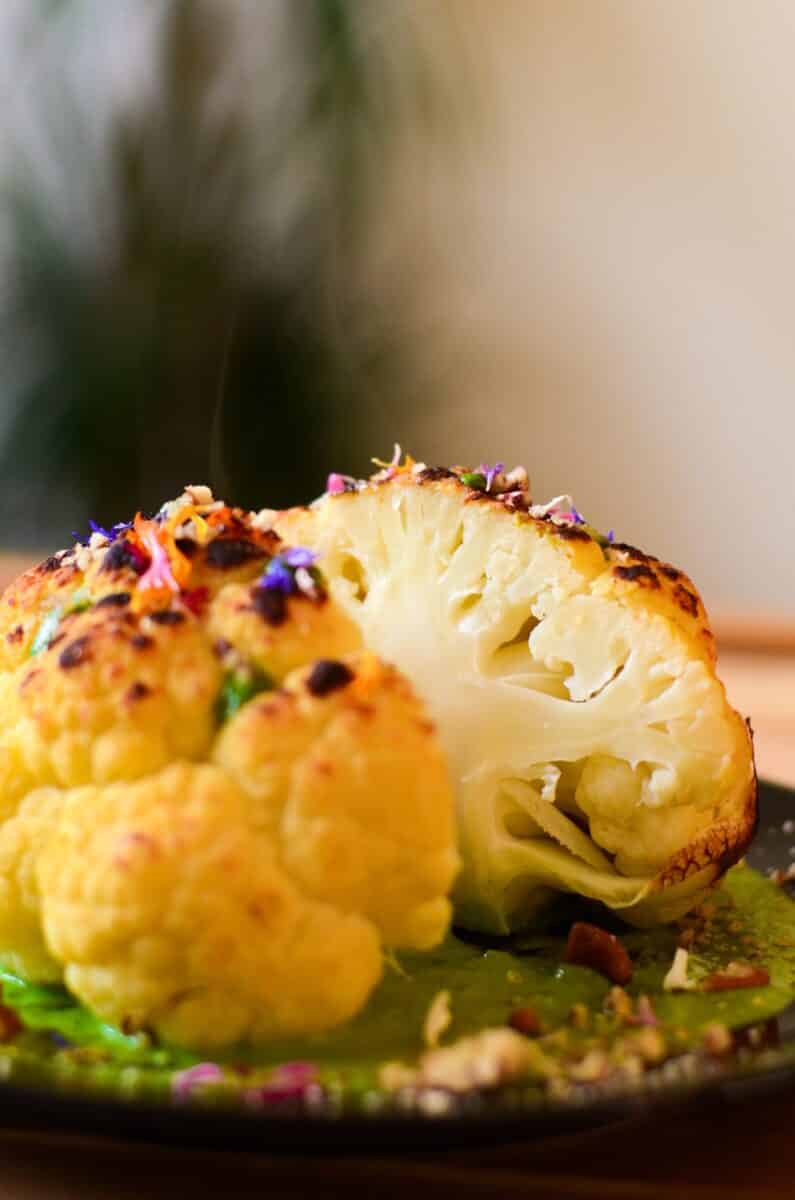
Ses nombreux attributs
Le chou-fleur prend d’assaut les étals des marchés en automne et en hiver. De la famille des crucifères (comme le brocoli), on salue la polyvalence de ce légume qui reste craquant sous la dent quand on le croque cru, et qui s’attendrit sitôt qu’on le cuit. C’est aussi un précieux allié pour notre santé! Riche en vitamines C, B6 et B9, ainsi qu’en fibres, en sélénium et en manganèse, il est peu calorique, antioxydant, anti-inflammatoire et diurétique. Doux au goût, il se décline en trois variétés principales: le chou-fleur blanc, violet et orange. À noter : c’est quand ses fleurons sont bien serrés et fermes qu’il est recommandé de le manger… ou de le congeler!
Ses multiples bienfaits
Les nutritionnistes parlent du chou-fleur comme d’un superaliment, puisque consommé régulièrement (et préférablement cru), ce légume contribuerait à réduire les risques de cancer du poumon, du côlon, des reins et des ovaires. L’apport en vitamine C que procure le chou-fleur bouilli contribue quant à lui au maintien de dents, d’os et de cartilages sains. La vitamine B6 qui s’y trouve outille pour sa part au mieux le système immunitaire, et la B9 aide tant à la régénération cellulaire qu’à la cicatrisation des blessures.
Sa polyvalence
Elle est révolue l’époque où l’on ne servait le chou-fleur que bouilli ou en trempette! Audacieux et ingénieux, les chefs cuisiniers aiment désormais bluffer leurs convives en exploitant le goût autant que la texture du chou-fleur, dans des créations 100 % véganes. Si bien que ce crucifère chéri est devenu un légume en vogue qu’on tranche, concasse, émiette et cuit à tout-va. Pas étonnant que des livres de recettes entiers lui soient dédiés… Et qu’à l’épicerie, au rayon du prêt-à-manger, on trouve désormais des pizzas en croûte de chou-fleur, des choux-fleurs frits ayant l’aspect de croquettes de poulet et même une panoplie de sauces à base de purée de chou-fleur! Caméléon et si bon, nous remercions le chou-fleur…
Les véganes aiment le chou-fleur dans tous ses états! Et ça se comprend: à cru, en papillote, sur le gril, poêlé, poché, réduit en purée ou cuit au four, ce crucifère « à tout faire » est bon en toute occasion. On lui fait une place dans notre assiette de juin à novembre, car c’est à cette période de l’année que le chou-fleur est cultivé partout au pays (le Québec produit d’ailleurs la moitié de toute la culture canadienne). Il suffit de laisser s’emballer notre imagination pour lui trouver de nouvelles vocations. Et histoire de vous faire saliver, voici nos suggestions: le gratiner avec le fauxmage Swisso, le servir en accompagnement du rôti de seitan Classico ou le transformer en pâte à pizza rehaussée de rondelles de saucisson Pizzaroni. À vos choux-fleurs. Prêts? Dégustez!
Quand le véganisme est l’objet de discussion, dans les 5 à 7 ou les soupers, certains mythes ont la couenne dure. Et à son sujet, on en entend souvent des vertes et des pas mûres! Passons au crible cinq idées préconçues qui font ombrage au mode de vie végane et départageons enfin le vrai du faux.
Mythe #1: Les véganes ont une alimentation carencée.
L’apport vitaminique et protéinique dont l’humain a besoin pour fonctionner ne se retrouve pas que dans la viande. Quand on adopte une alimentation végane et qu’on ingère chaque jour une juste combinaison de fruits, légumes, céréales (millet, quinoa, sarrasin, etc.) et légumineuses (pois chiches, lentilles, haricots, arachides, etc.), pas de carences en vue, ni de baisses d’énergie. Notre article intitulé « Quelles sont les meilleures sources de protéines végétales? » explore la question plus en profondeur.
Mythe #2: Le véganisme est incompatible avec la pratique de sports professionnels
Quand ils s’adonnent à d’intenses activités physiques, les sportifs dépensent une tonne d’énergie. Pour leur permettre de performer, les protéines arrivent en renfort. C’est un peu le carburant du corps: plus on avance à fond de train, plus il faut refaire le plein! Et pour soutenir le rythme des sportifs de haut calibre, les protéines végétales n’ont rien à envier aux animales. Pas convaincus? Sachez que l’ex-boxeur Mike Tyson et le pilote de Formule 1 Lewis Hamilton sont tous deux champions ET végétaliens.
Mythe #3: Faire une épicerie végane coûte beaucoup de sous
En plus de délicieux fruits et légumes, l’alimentation végane regorge surtout de pâtes, de céréales et de légumineuses. Et en comparaison des produits laitiers, des viandes et des poissons, ces denrées se vendent à prix doux. Il est même possible d’en faire des stocks tellement elles se conservent longtemps!
Mythe #4: Le véganisme, c’est pour les granolas et bohémiens de ce monde
Que nenni! Si les hippies ont été les parmi les premiers à plébisciter l’alimentation végétalienne, le portrait-type du végane s’est beaucoup diversifié depuis. Sportifs, acteurs, chanteurs et entrepreneurs bien connus sont adeptes du véganisme et pourtant pas granolas pour deux sous! On n’a qu’à penser à Woody Harrelson, Moby, Brad Pitt et d’autres, qu’on vous présente dans cet autre article de blogue.
Mythe #5: L’alimentation végane est redondante et peu variée
Le véganisme est moins restrictif qu’on le croit. Entre légumineuses, céréales, pâtes, fruits et légumes, les véganes ont de quoi se remplir la panse. Même que de plus en plus de restos, marques et commerces proposent des menus et aliments végétaliens. Et pour peu qu’on cuisine ces derniers de façon inspirée (parcourez nos recettes originales), ils confondent les plus sceptiques. Un vrai délice!
Quand on creuse la question, on constate que le véganisme gagne à être mieux connu. Et on réalise, au passage, que l’alimentation végane a un petit je-ne-sais-quoi de séduisant… Désireux de vous tourner vers des saucisses, rôtis, burgers et fromages de composition végétale? Les produits GUSTA, faits au Canada, sont là! Découvrez-les ici et faites-en l’achat en épiceries.
